Playbooks and guides by Grizzle


In this article, you’ll learn how to create a digital PR-driven link building strategy, the content formats that generate natural backlinks, and how to achieve a link acquisition rate of 44% from your outreach.
Link building and the law of shitty clickthroughs
Most link building advice focuses on tactics like “broken link building” and the “skyscraper technique.” However, these approaches quickly lost their effectiveness due to how popular they became.
People bombarded link creators with emails that followed the same framework:
- A personalized first line containing a superficial compliment
- Details on the broken or outdated links in their content
- A request to replace it with newer, “better” content
It’s not an attractive offer. You’re competing with dozens of SEOs following the same advice, even using identical email templates word-for-word. Some people suggest nurturing link creators on social before reaching out, but this is both time-consuming and insincere.
This results in burning relationships before they’ve even begun. There’s a misalignment between common practice and what link creators care about.
The more link creators are exposed to an approach, the more they’re aware of the intent behind it and the less effective it becomes. It’s the law of shitty clickthroughs in action.
The solution: produce creative and data-driven content
The link building practices above lack three critical elements to successful, long-term link building:
- Creating something truly interesting;
- Providing link creators with something they value, and;
- Intelligent, well-targeted outreach.
This means producing data-driven and creative content while establishing long-term partnerships with link creators, not treating them as commodities.
This philosophy is how we’re able to generate an average response rate of 37.5% and a link acquisition rate of 44% across our B2B digital PR campaigns.
Two proven principles must act as the foundation for your digital PR and link building campaigns:
- Data: Collect data in the form of studies or benchmarks, or curate existing and third-party data to create a unique narrative
- Creativity: Produce assets, media, and tools to ride trends and delight audiences
Let’s dive into three specific formats that employ these principles, along with examples from brands who use them:
1. Become a go-to source of data with industry reports
Studies and data-driven reports are a tried-and-tested approach to digital PR. They help link creators back up their claims while offering readers new insights.
However, most industry studies fail to share something new. If they do, it’s executed in such an uninspiring and uninteresting way that they capture little attention.
This low bar for quality means it’s easy to stand out for marketers willing to put the work in. Providing a better experience, using good content design principles, or building interactive user experiences give link creators something attractive they can use in their stories.
For example, Mailmodo has positioned their State of Email 2023 report as a product they’ve heavily invested in:
Mailmodo improve the report’s perceived value by:
- Collaborating with other SaaS brands during the production and promotion phases
- Communicating the value of the ebook with benefit-driven copy
- Increasing social proof by adding the Product Hunt “#4 product of the day” badge, further cementing its positioning as a standalone product
Buffer is another example of how great content design can improve performance with their State of Social report:

At the time of writing, Buffer’s report has generated over 2,800 backlinks across 1,220 domains—including mentions in Entrepreneur, HubSpot, Search Engine Journal, and other leading business and marketing publications:
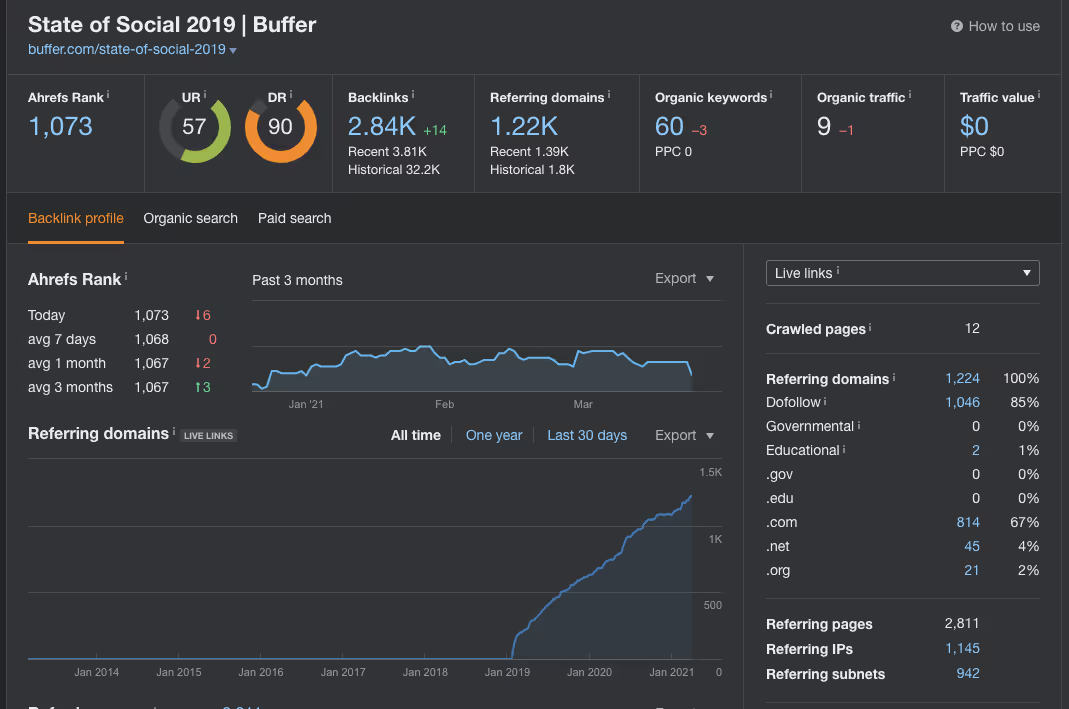
While these reports generate little search traffic, the increase in domain authority combined with intelligent internal linking lifts all ships.
1. Find a relevant and unique angle
All great data-driven projects start with a unique angle. For example, dozens of sales studies are conducted every single year. Pipedrive is one of the few to create a statistically-backed, journalistic-style dive into the state of diversity and inclusion in the sales workforce:
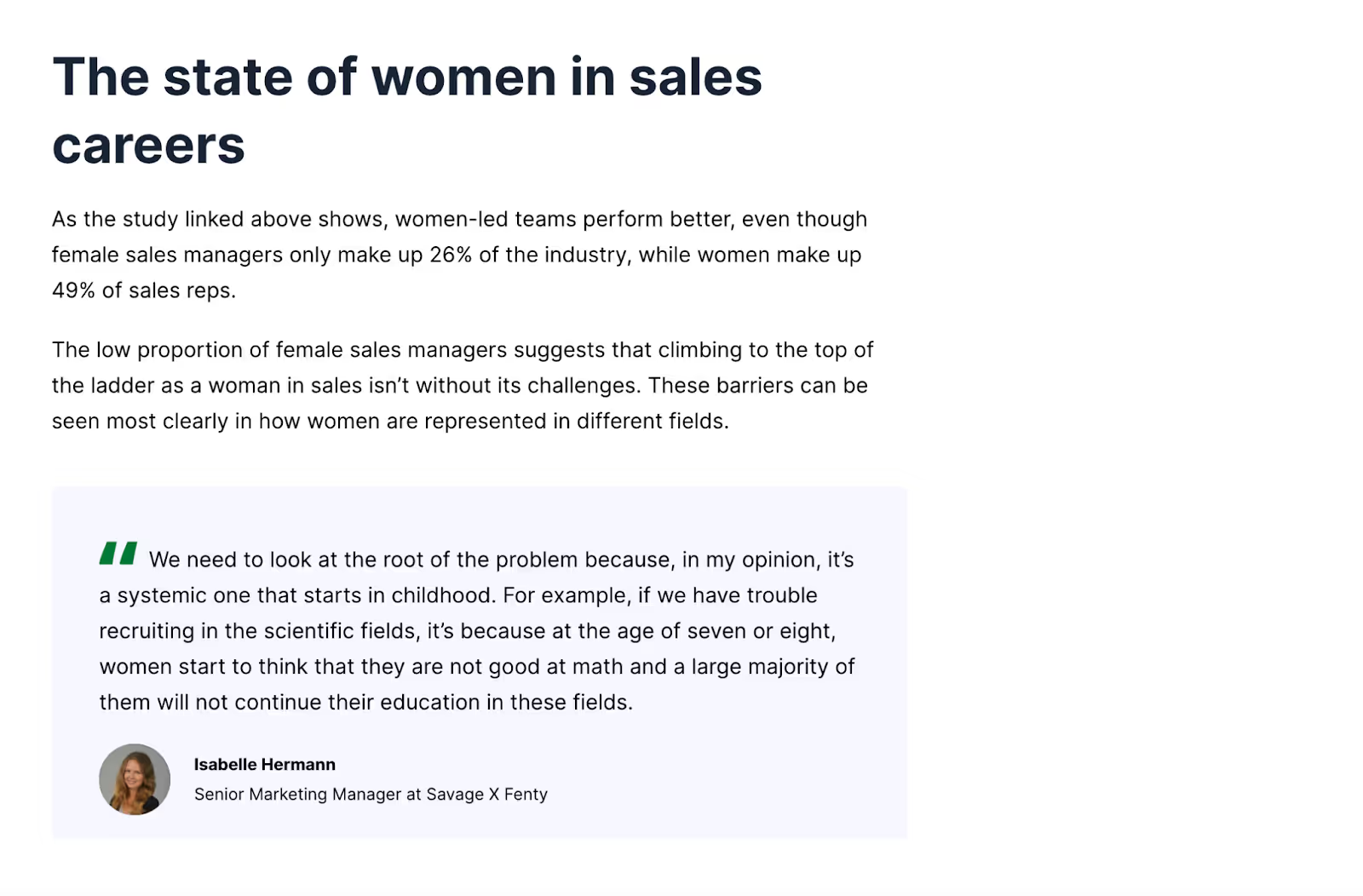
Find an evergreen angle, or uncover a newsworthy trend that’s top-of-mind in the industry zeitgeist. You can do this by:
- Following influencers who regularly share industry updates
- Using tools like SparkToro or BuzzSumo to identify emerging trends
Focus on rising trends that are most relevant to your brand, product, and audience.
Furthermore, prioritize those where you have experiences, stories, and expertise to further hypothesize around the data. This is how you position yourself from a “resource hub” to a true thought leader.
2. Collect and source statistically significant data
The most challenging part of this process is sourcing a statistically significant dataset.
We’ve found the most effective methods of collecting data are:
- Analyzing owned product data. For example, an email marketing platform organizing open rate benchmarks across industry segments.
- Scraping publicly available data. For example, scraping the backlink profiles of data-driven content from Ahrefs.
- Industry and persona surveys. For example, collecting 500 to 1,000 responses from content marketers for a “State of Content Marketing” survey.
- Collaborating with other brands. For example, offering an audience intelligence brand to analyze their owned data to produce a benchmark report.
Collecting data is just the first step. Finding if there’s a story worth sharing requires careful and honest organization of the dataset you’ve collected.
Finding a data analyst to help you is key. The best analysts also understand that the way data is framed will inform the narrative. Get them involved from the very beginning of your project to ensure good data hygiene and accuracy.
3. Package up key findings for link creators
While data is the foundation of great data-driven content, presentation is key. Accompany your data with beautiful visual assets that content creators and journalists can easily embed in their content.
For example, Pipedrive repurposed the most interesting findings from their State of Sales report into a blog post, complete with easy-to-share infographics:
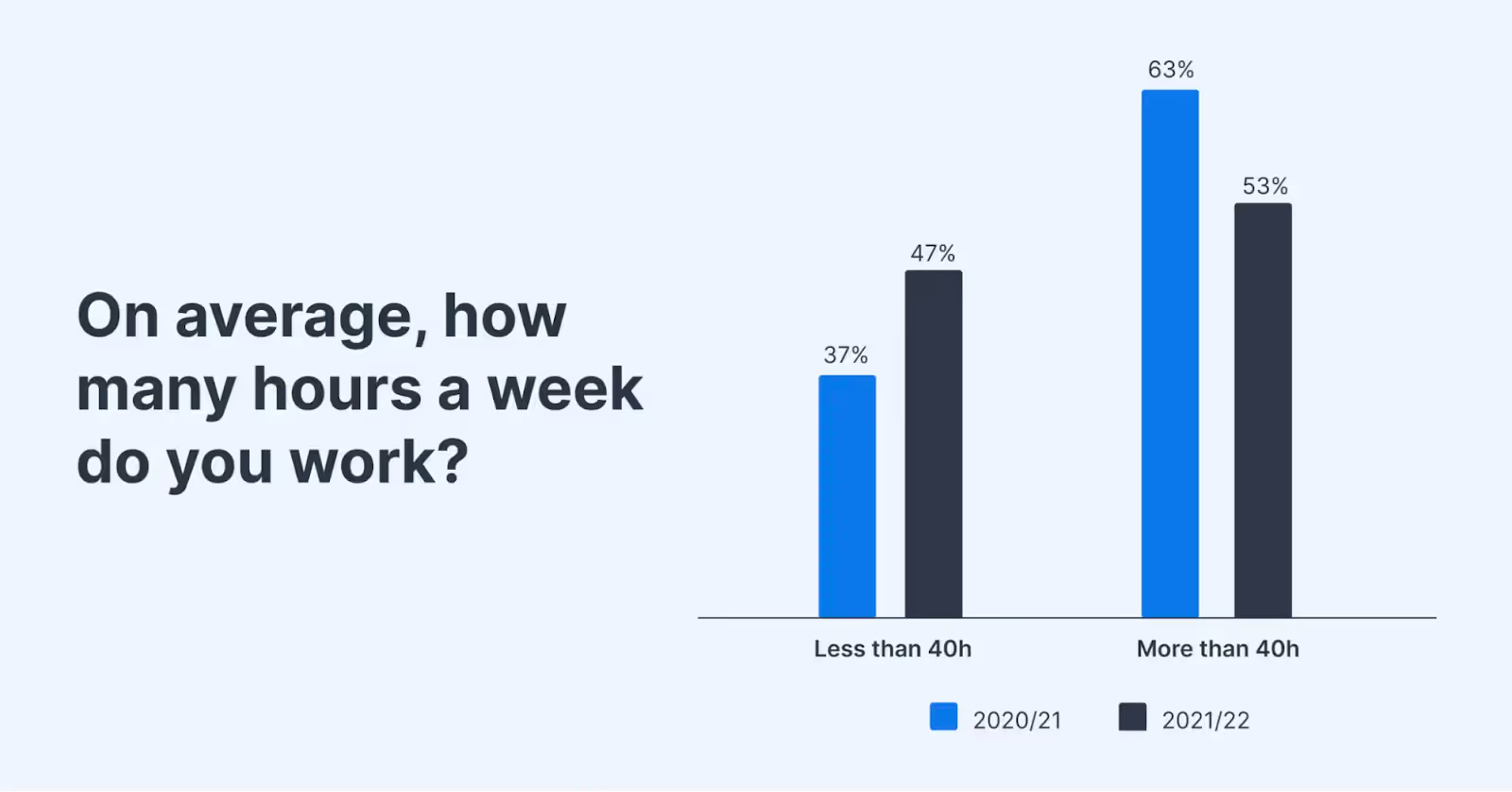
This makes earned content more engaging for readers while extending the reach of your owned content. As more people organically discover your story, the more natural links you’re likely to generate.
Add your opinion to build thought leadership around your findings. Include this in your outreach as commentary to empower journalists to tell the full story.
2. Elicit emotional responses with video content and documentaries
While there will always be a place for information, stories allow you to build a stronger connection with your audience and, importantly, the buyers considering investing in your solution.
The term “B2B” can be misleading. We’re really marketing to the people within an organization. Using media to share your customers’ struggles and successes not only establishes deeper connections, but help improve content marketing and SEO performance in the process.
For example, Mailchimp Presents is a solid example of using documentary-style video content to share customer stories. Creating their own Netflix-style platform, each series focuses on various topics in the realm of entrepreneurship, business, and the future of technology:
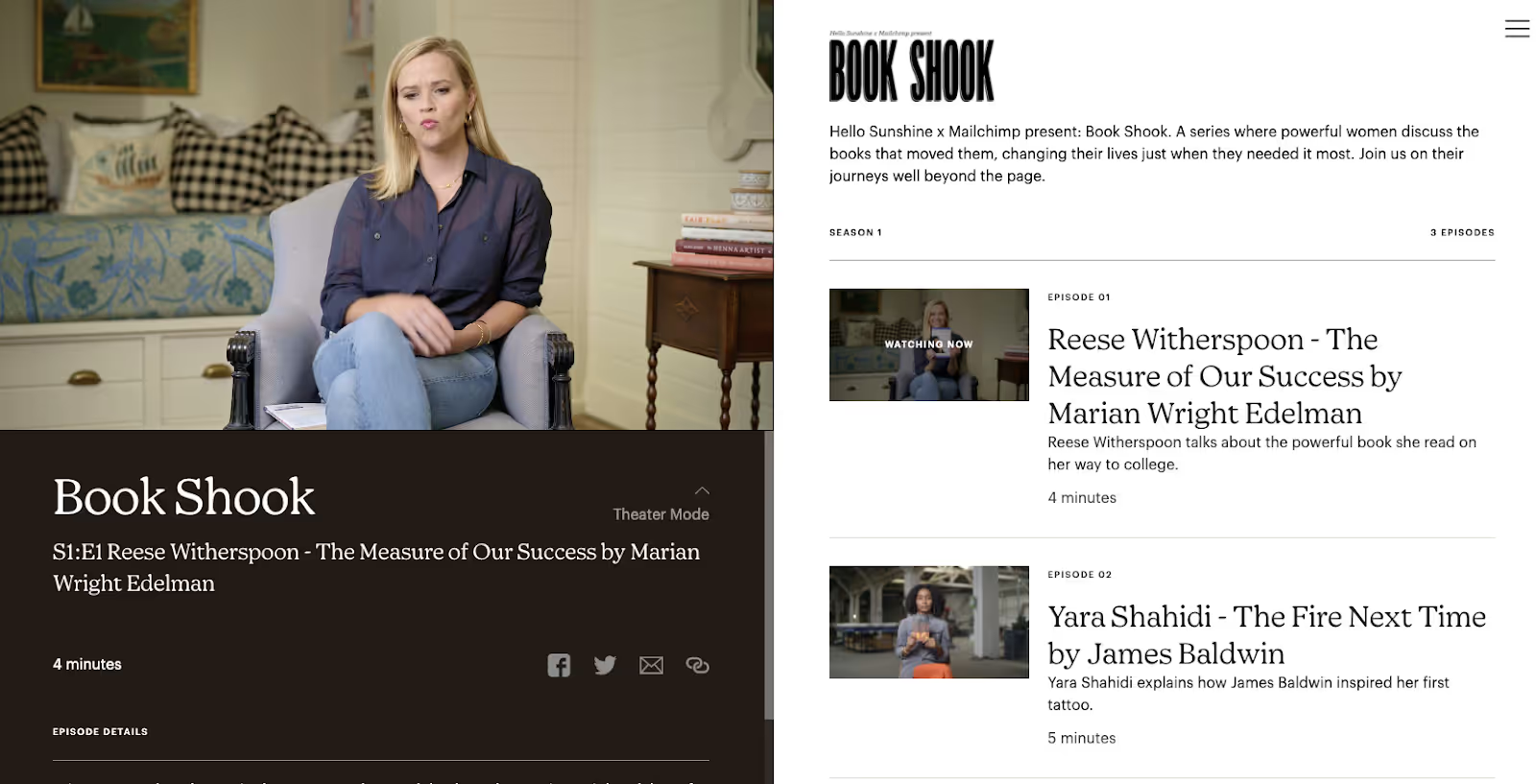
Their series “Book Shook,” as illustrated above, partners with influential and successful women like Reese Witherspoon and Jameela Jamil to share the books that have influenced them:
Mailchimp’s collection of video content is a tremendous source of backlinks, garnering media coverage every time they launch a new series. Each series launch is met with bursts of coverage followed by sustained backlinks:
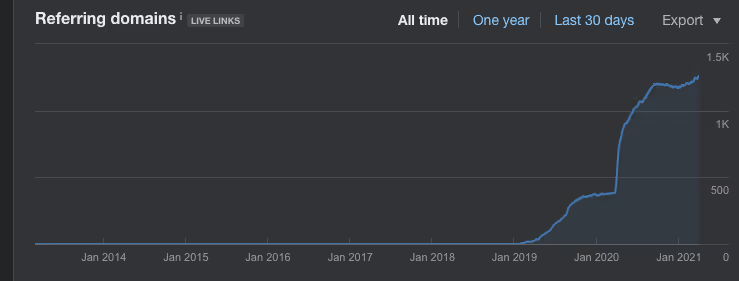
How to create video content at scale
The best marketers make sure their brand gets out of the way of a good story. They make sure their customers or partners are the star, elevating the struggles and successes that their audiences truly care about.
Black Fish covered the corruption of Sea World, but the story was really about Tilikum.
The first step is to find your muse. What story do you want to tell, and who does it belong to? This can include experts within your organization, but don’t forget to look outside and ask yourself: who else would our audience be interested in learning from?
Next, decide on a format. Will it be an episodic series, a one-off video for YouTube, or a podcast?
Understand which formats and platforms your audience is already familiar with and cater to those tastes. Kristen LaFrance does a terrific job of this with Shopify’s Resilient Retail:
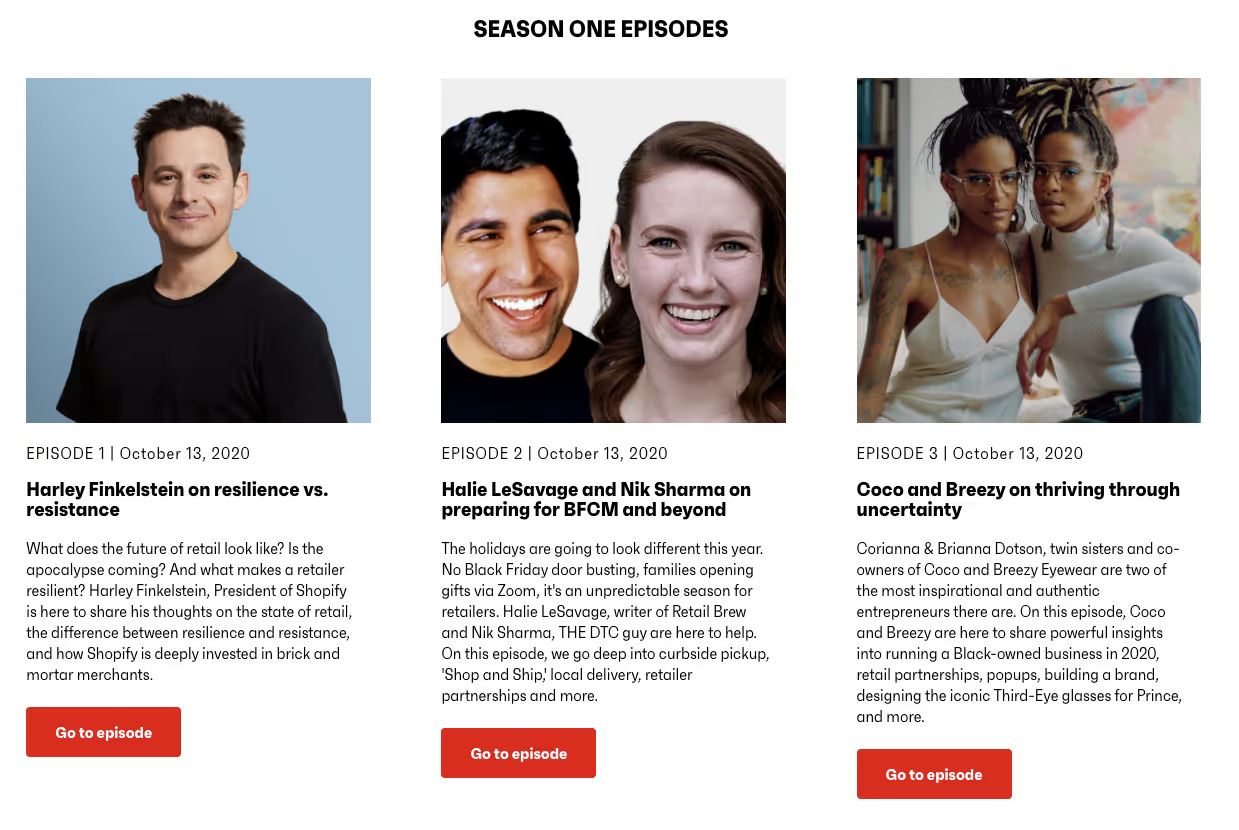
Don’t forget about the repurposing power of your content. Each video can be repurposed into podcasts, short-form video for social, and long-form blog content. Recycle it over and over again for maximum visibility.
Video content production can seem daunting, but it’s not nearly as complex or expensive as it used to be. Check out our complete guide to video content production to learn more about scaling your video marketing.
By starting small, you can replicate Mailchimp’s approach to building a media brand centered around high-end production values.
Collaborate with other creators to enrich your stories while helping them access a wider audience to capture as much attention as possible. This improves the quality of your content, broadens the stories you can share, and gives you access to a wider audience in the process.
3. Generate buzz and excitement with standalone resources and tools
Launching standalone products, tools, and microsites can generate vast amounts of buzz and attention. A great example of this is Mention’s Influencer Marketing Stack:
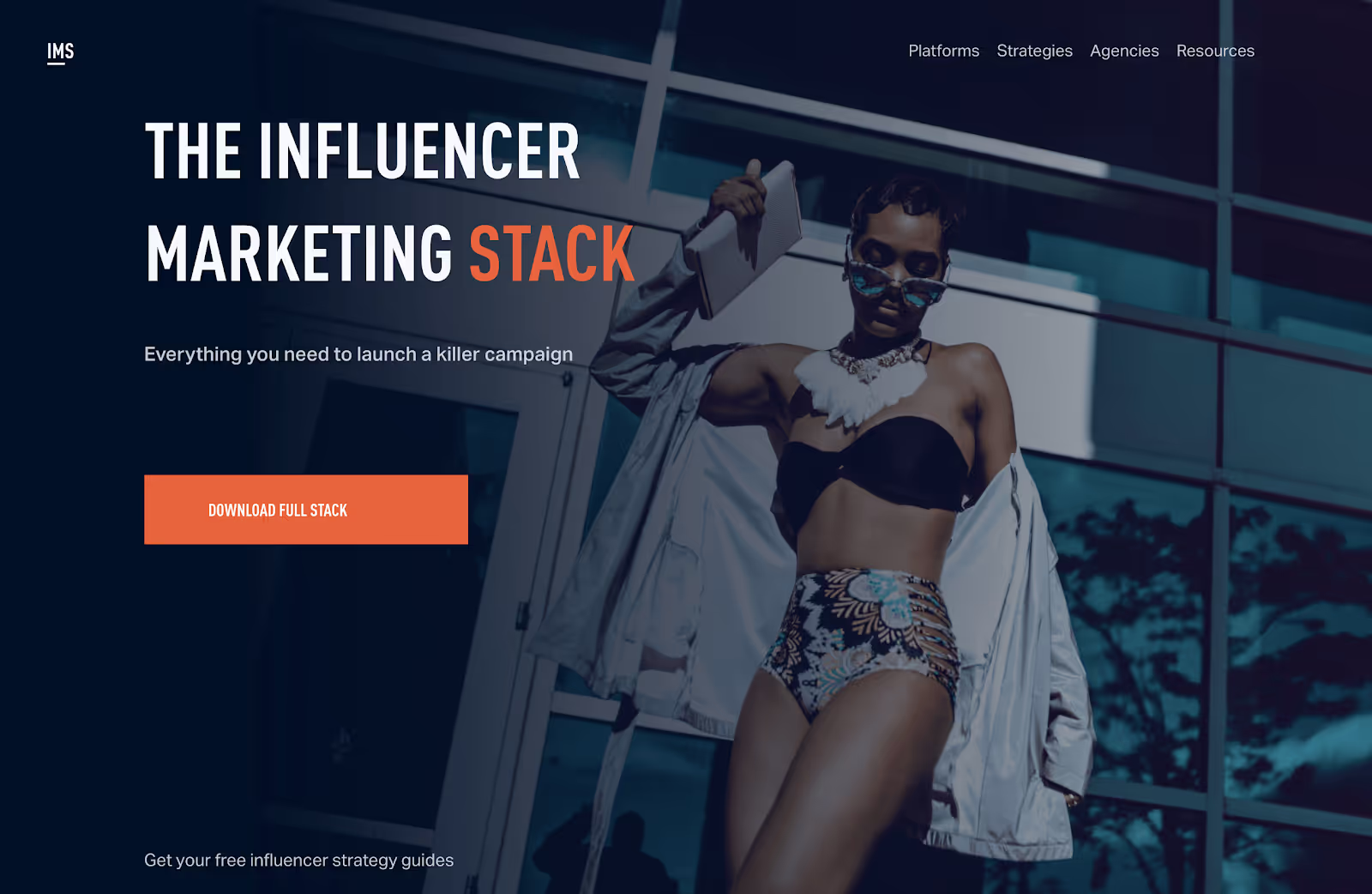
This standalone resource has generated over 1,900 upvotes on Product Hunt and over 847 backlinks from publications like Inc., The Next Web, and Content Marketing Institute.
Here’s what Mention did that helped make this resource a success:
- They exceed value expectations: The microsite provides tools, a directory of agency vendors, and how-to information that marketers can learn from.
- They partnered with top brand: Collaborating with the likes of HubSpot, Later, and BuzzStream extended their reach while increasing the authority of the resource.
- They followed a deliberate launch plan: Mention didn’t achieve success by accident. They coordinated with partners and advocates to make as big an impact as possible on launch day.
Not only do microsites and standalone resources serve your audience, they also provide link creators with a source they can refer to in their own articles and stories.
How to rapidly create and launch resources and tools
Even when building products for digital PR, you must start by discovering what the market is hungry for—or at least curious about—and validating it. Just like you would any other product.
Talk with link creators you already know for their opinion on your project. Share its purpose and how you plan on delivering value to your audience. Ask them for their opinion and validate its coverage potential.
Customer research is critical for finding new angles and validating what you’re building. We’re not building a startup here, so a burning problem isn’t required. However, your resource or tool should provide utility and garner some level of excitement.
If you’re building an app or software, enlist the help of in-house engineers or an agency like Grizzle. Alternatively, use no-code tools like Bubble and Webflow to build an MVP without technical know-how.
The same goes for microsites. Building standalone experiences is easier than ever, thanks to no-code development tools and website builders.
Create something worth linking to
If your link building KPIs look a little flat, consider evaluating what you’re creating and how you’re reaching out to link creators.
Most journalists, bloggers, and influencers are always looking out for new stories to cover. However, if you’re not seeing the results you expect, it’s likely they’ve seen what you’re offering a thousand times.
Reverse engineer where their attention is going. Think beyond skyscraper content. To acquire links, offer something truly interesting. Do away with superficial outreach and see your response rates soar.


In this article, we’ve compiled “link acquisition velocity” data from Buffer’s backlink profile and 10 of the top SaaS blogs to answer this question.
You’ll learn where data-driven content fits in the content ecosystem, how to get started, and methods to accelerate your organic growth with digital PR experimentation.
The discrepancy between blog content creation and link acquisition
92% of the 1,500+ marketers interviewed in a study conducted by Semrush say they invest in blog content. Further, 89% said they rely on organic search for distribution—making SEO the most popular distribution channel.
However, only 24% said they rely on external publications or guest blogging (what we call digital PR) and 22% said they create original studies and data-driven content:
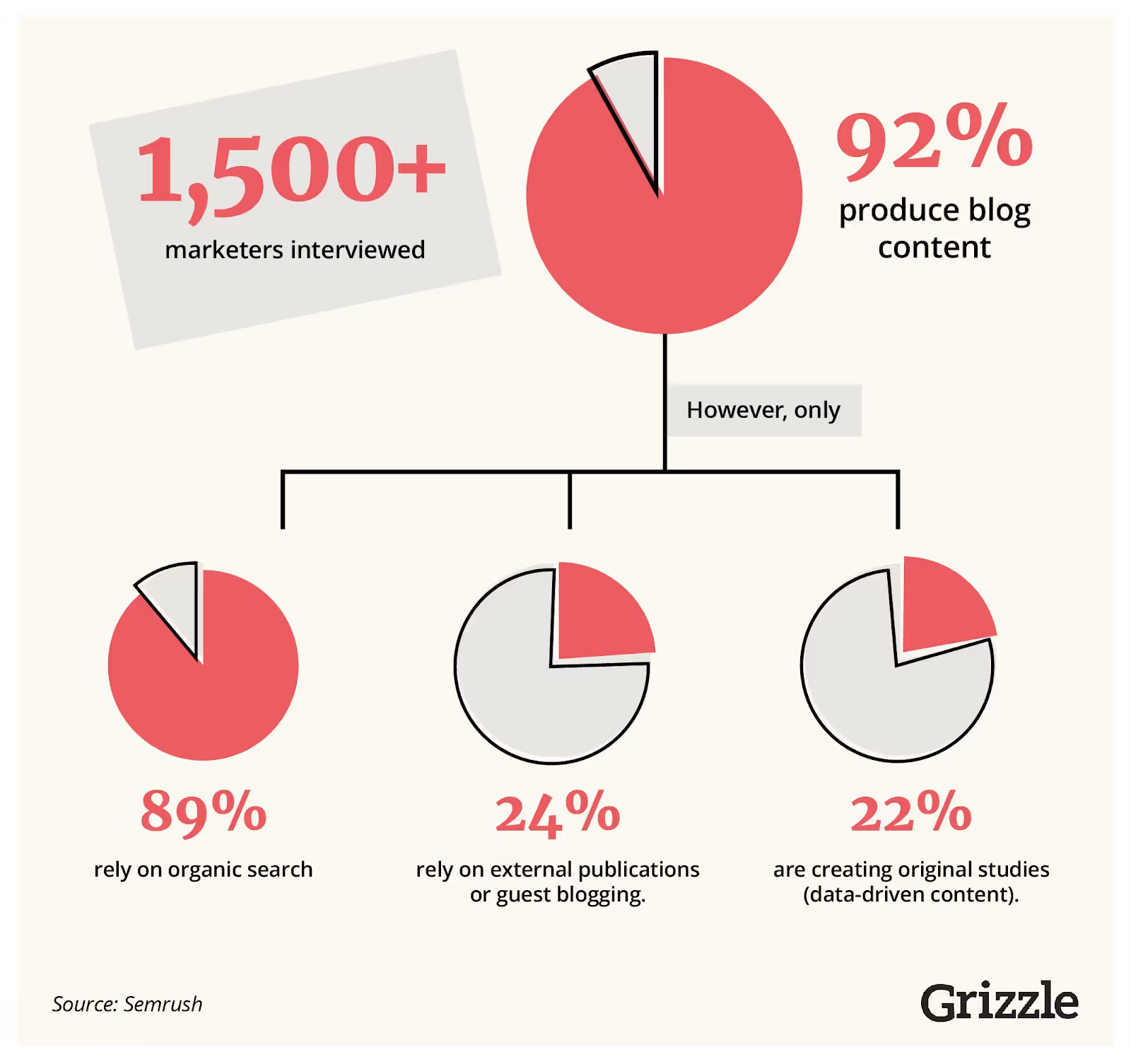
If data-driven content generates more links than editorial content, this means that over 75% of marketers are leaving opportunity on the table.
But is this truly the case?
How Buffer generated 100 links in 14 days
Buffer is well-known for its social media marketing content.
On top of in-depth editorial content, they also produce data-driven studies like the "State of Social" report:

Here, Buffer surveyed 1,800 marketers about their social media strategy, presenting their findings wrapped in a bespoke UI.
At time of writing, there are over 1,280 referring domains (RDs) pointing to this single piece of content.
Let’s compare this to the top 10 Buffer blog articles that rank for position 1 on Google (ordered by search volume):
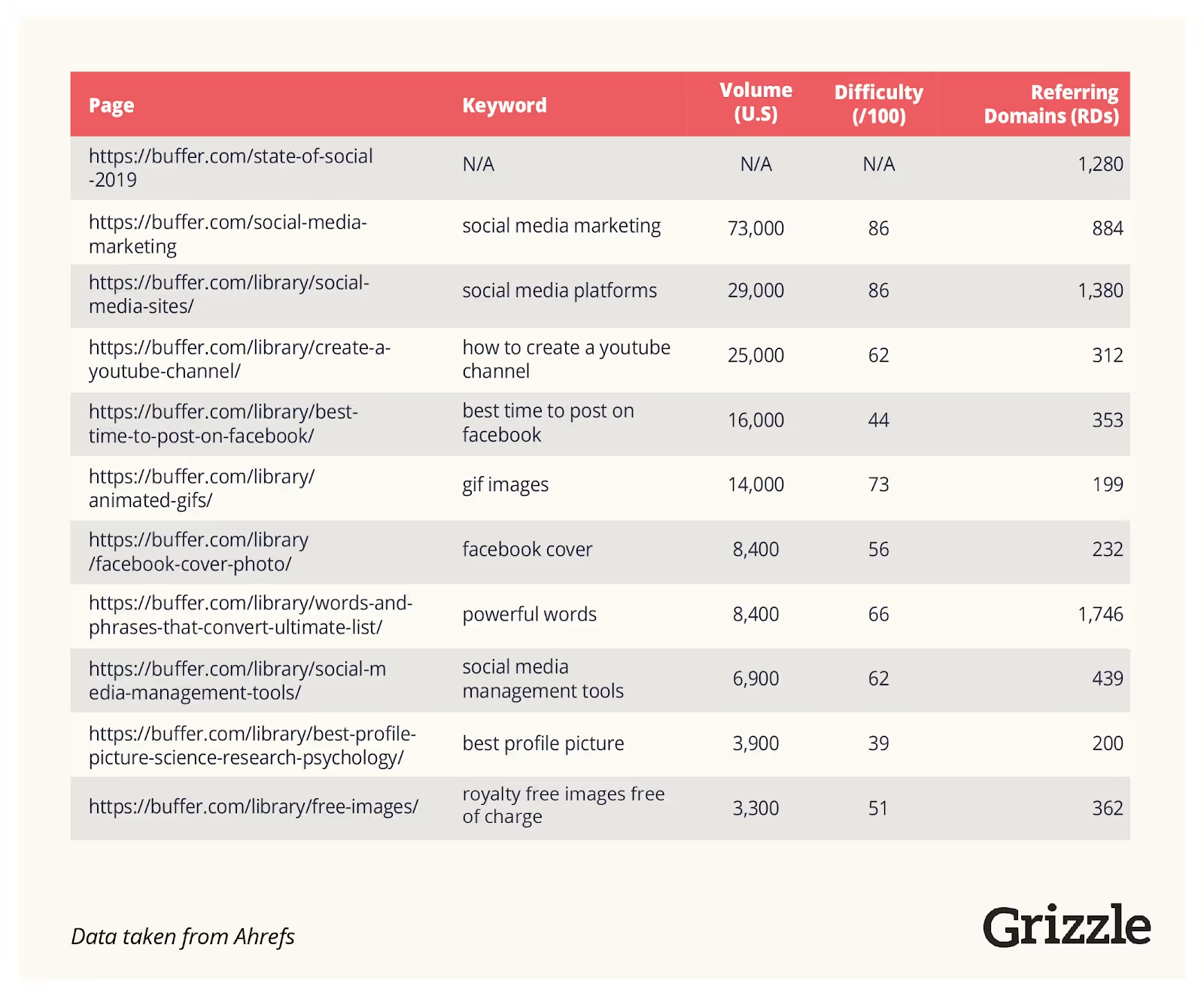
From this data we observe:
- The average number of backlinks from unique referring domains (RD) across their top 10 articles is 373.45.
- “Social Media Sites” is a clear outlier, generating more than 1,300 RDs.
To gauge the impact Buffer’s content has on their link building efforts, we’ll use a proprietary metric called link acquisition velocity (LAV).
LAV is a measurement of how quickly it takes for a piece of content to generate a specific number of backlinks. Let’s say your goal is to generate 50 links, and it takes 32 days to reach that goal. That piece of content would therefore have a LAV of 1.56:
LAV = No. Links Generated / No. Days Taken to Acquire Them
Focusing on LAV allows you to experiment and iterate, which is critical for SaaS brands with long-term distribution and digital PR programs. If you find a specific content format has a higher LAV than others, you can deploy more resources with a higher level of confidence that they’ll perform.
When experimenting, it’s a more reliable metric than total links as it gives a greater sense of demand for a specific type of content in the market.
Going back to Buffer’s link profile, let’s compare LAV between their “State of Social” report and “Social Media Sites” article:

According to this data, LAV was 293% greater for “State of Social” than “Social Media Sites.”
Furthermore, “State of Social” generated 243% more links than “Social Media Sites.”
Before drawing any conclusions, we must factor in how Buffer has brand equity and a large existing customer base on their side. They already have the attention of other bloggers and journalists they can launch to in order to gain traction.
Where do other SaaS brands stand?
Data-driven content is one of the most linkable assets a B2B brand can produce.
But Buffer might be an outlier. Where do other SaaS brands stand when it comes to data-driven content and digital PR?
We’ve compiled a table of data-driven reports produced by 10 SaaS brands (including Buffer) and the number of RDs and backlinks they’ve each generated:
The number of RDs vary, even for well-known brands. However, considering the first result in Google has an average of 3.8x more backlinks than pages ranking at positions two to three, even a dozen or so links can make a huge impact.
The best way to generate backlinks is by producing content that link creators are hungry for. Clearly, for B2B and SaaS companies, these formats include proprietary data, studies, analysis, and expert commentary.
A key issue is that data-driven content doesn’t necessarily generate search traffic as a standalone asset. Not many people are searching for “state of social reports.”
So, to improve the performance of content across your entire topic cluster, use intelligent internal linking practices.
For example, Ninja Outreach increased search traffic by 40% just by fixing the internal linking between blog articles:
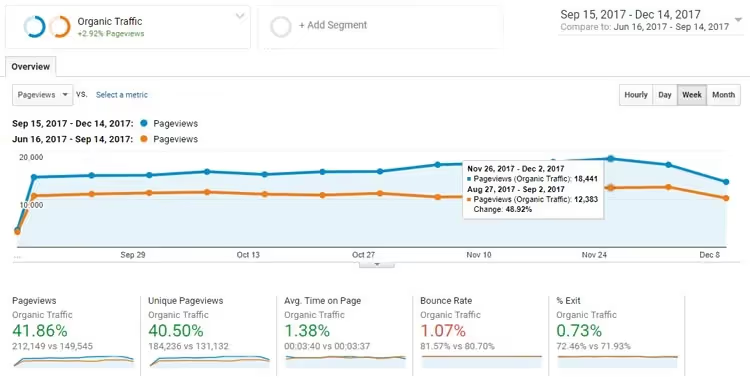
To further back this up, Google has explicitly said that internal links are important;
“Google must constantly search for new pages and add them to its list of known pages. Some pages are known because Google has already crawled them before. Other pages are discovered when Google follows a link from a known page to a new page.”
Building a digital PR strategy at the intersection of expertise, data, and growth
Based on this research, we can conclude the following:
- Links are critical for organic growth
- It’s far easier to generate links to data-driven content than editorial content
- Internal linking impacts organic traffic across our entire content portfolio
- Editorial content generates large amounts of search traffic for high-volume keywords (when done right)
Embedding data-driven content into a hub and spoke strategy is the best way to generate links and accelerate organic growth across the board.
A hub and spoke model that integrates data-driven content looks something like this:
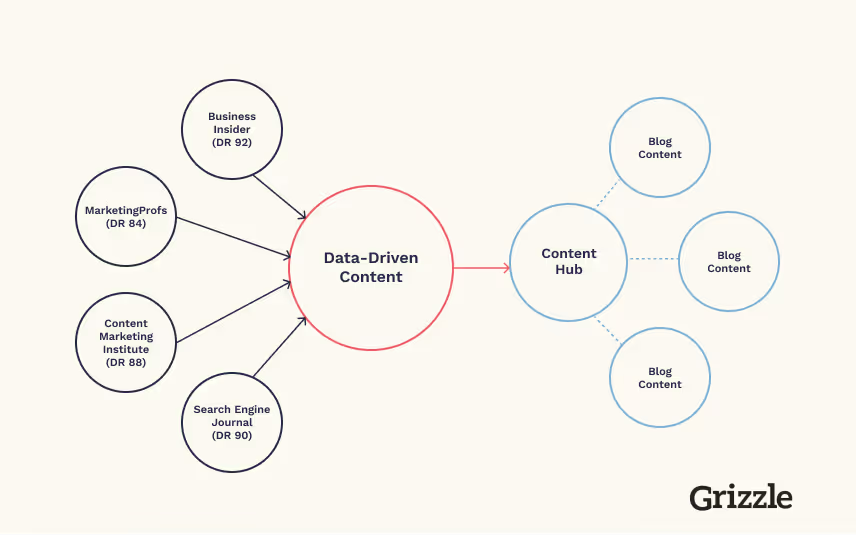
Here, data-driven content acts as an "entry ramp" for backlinks to enter our content portfolio.
Let’s say your goal is to generate links from publications with a high domain rating (DR). Doing this increases the page rating (PR) of your data-driven content, which is then passed down to your content hub and blog articles, further boosting your topical authority.
Your data-driven content ideation should fit in the sweet spot between:
- What journalists and editors are hungry for;
- What the market is talking about;
- Your growth and demand generation priorities.
For example, if you’re looking to build topical authority in the “talent acquisition” space, consider running a study on “top hiring challenges among HR managers.” Avoid adjacent topics like performance management until you’re ready to enter that arena.
The same goes for promotion. Outreach and relationship building must be baked into your content distribution roadmap, allowing you to establish content-channel fit.
[[component]]
Reduce uncertainty with digital PR experimentation
Many SaaS marketers invest huge amounts of resources into data-driven content.
This can make a big impact, as link creators love to cite original sources in their own content. While no marketing endeavor is guaranteed to get results, the time and money involved in data-driven content creation may seem disproportionate to the potential ROI.
Therefore, a better approach is to run several low-effort experiments across a quarter or two.
This involves planning, producing, and distributing data-driven content, quickly, using the following process:
- Analysis & Ideation: Identify trending topics in the market and source data from owned or publicly-available sources. Create a unique narrative around your findings. Recruit subject matter experts across your organization to give commentary that link creators can use to build out their stories.
- Data-Driven/Creative Content Production: Package up your data and commentary in a way that link creators can deploy quickly and easily. This includes blog posts, visual content, and access to raw datasets (as long as it complies with data protection laws).
- Personalized Outreach: Get your content in front of the people it’s most relevant to. This is how you build long-term relationships and stand out in an inbox full of generic pitches.
Furthermore, give yourself multiple chances to win by coming up with several angles. For example, if a study on the “best cities for marketing careers” falls flat with marketing blogs, try recruitment or HR publications instead.
Build upon content formats with a high LAV by investing in more ambitious projects.
Diversify your content portfolio
Data-driven and creative content has been proven to generate links. If your goal is to accelerate organic growth, focus on the formats with a high link acquisition velocity (LAV).
Build out your topic clusters, produce content that link creators need, and utilize internal linking to create a content portfolio that ranks for even the most competitive keywords.


When built the right way, B2B influencer relationships can be invaluable.
- They can lead to business development opportunities
- They can help you distribute your owned content to a larger audience
- They provide an opportunity to work on co-marketing projects together
The trouble is, most advice begins and ends with “provide value", which usually comes in the form of sharing content, mentioning them on social, and commenting on their blog posts.
But busy influencers are bombarded with these social notifications and cold emails on a daily basis. What influencers really need help with is getting their message, brand, and story in front of a larger audience.
In this guide, you’ll learn how to build long-term, meaningful relationships with influencers by getting them in front of a wider audience. You’ll learn how to engage with them, create content for other people’s audiences and create win-win scenarios for all involved.
The best bit? You get to create amazing content for a wider audience in the process.
Here’s how.
Identify relevant influencers
Not all influencers are made equal. And those you target will depend on your marketing goals.
For example, if you’re looking to establish co-marketing efforts (e.g. a co-branded eBook) with another non-competing brand, you’ll want to target senior marketers.
Perhaps you’re trying to expand your audience? Then you’ll want to engage with thought leaders who create great content for a large, engaged audience.
You should already have an idea of who you want to connect with. But you might also be looking for other opportunities outside of your “frame of reference.”
Here are some techniques to identify the best thought leaders in your space.
1. Use BuzzSumo for data-driven validation
Influencers are already sharing great content. You just need to find it.
BuzzSumo is just the tool for this job. With it, we can identify top-performing content and the influencers who shared it.
Let’s say we want to engage with influencers interested in chatbots. Type a keyword (e.g. “chatbot marketing”) into BuzzSumo and look at the top results:
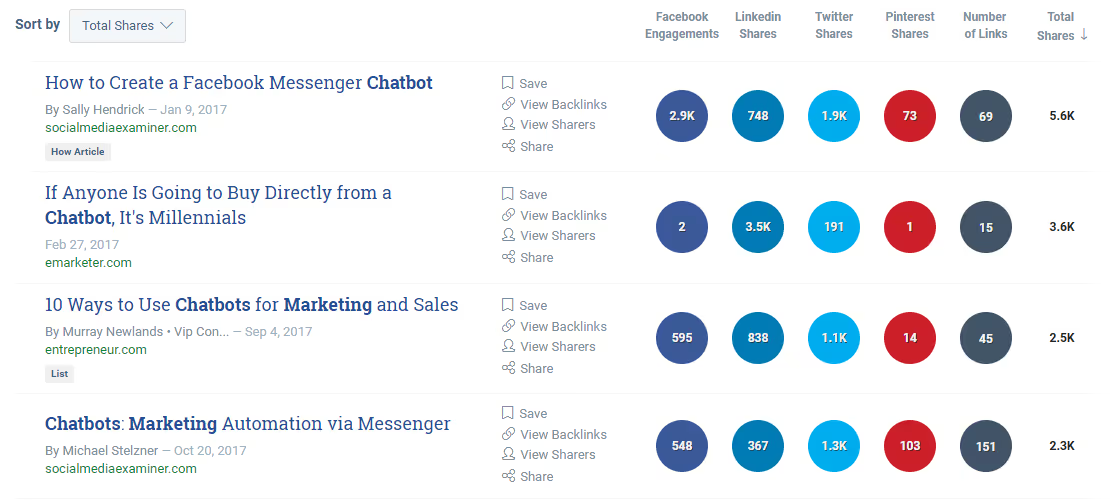
Click on “View Sharers.” You’ll be taken to list of Twitter users who shared this content:

If you’re on the free version of BuzzSumo, order the list by Twitter Followers and identify individuals who would be a good fit.
For those on the premium version, we can download a CSV and perform some data wrangling. Click the “Export” button at the top right of the list and select “CSV.”
In Excel or Google Sheets, filter the data as follows:
- num_followers: > 5,000
- person_type: deselect any with [company]
- num_followers: order by largest to smallest
- Place name, URL and bio columns together (you may need to paste filtered data into a new spreadsheet to do this)
Moving these columns together makes it easy to sort through the list. You want to find users that have authority beyond the size of their followers.
Phrases such as “author,” “CEO” and “founder” are all indicators of legitimate influencers. Ignore users with their Pinterest or Facebook profiles listed.
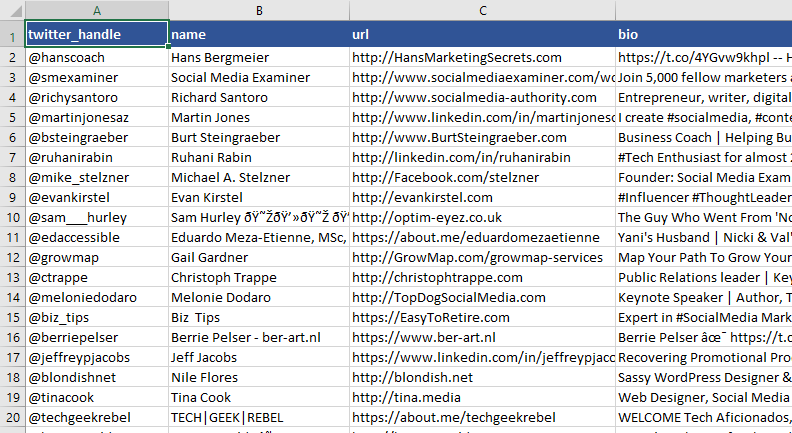
Add these to your list of target influencers.
2. Find Popular Brands to Partner With
When we think of influencers in the B2B space, we often think of bloggers, authors, and thought leaders.
While there’s some overlap, we often overlook “organizational leaders” – the senior decision makers and movers and shakers who work for other brands.
There are several benefits to strategic partnerships like these:
- They can help you reach a larger audience
- You can establish a partnerships to promote your content to each other’s audience
- You can create co-branded content
For the sake of this guide, we’re going to focus on co-branded content.
So, what exactly is co-branded content?
Co-branded content is a long-form asset (usually an eBook, report or webinar) co-authored by two (or more) brands. It helps increase the awareness and authority of both brands while generating qualified leads.
When starting up his agency, KlientBoost, Jonathan Dane decided to sacrifice “owned” content for partnerships. He identified software companies with access to his ideal clients and created co-branded eBooks with them:
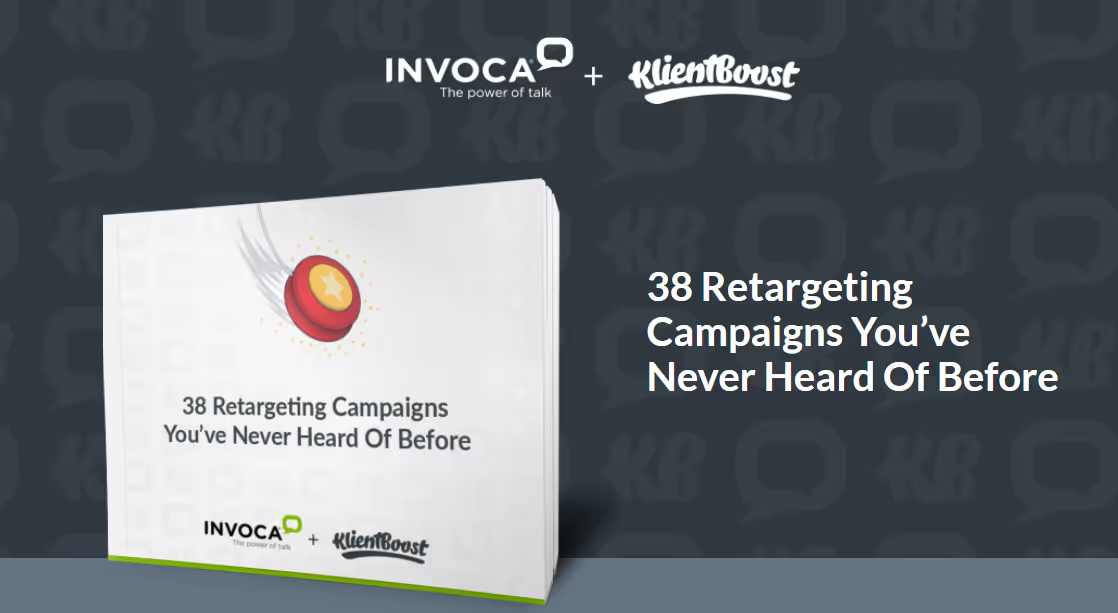
As a result, KlientBoost grew from nothing to $1 million in revenue within a year. That’s the power of other people’s audiences.
Find brands using the BuzzSumo technique above. This time, include companies in your search. Look for influencers who have their company and job title in the bio.
LinkedIn is another great place to find potential partners. Using the advanced search features, you can find individuals within companies who would make great partners:

Tracking influencer activity & metrics
When identifying target influencers, you must keep track of the right metrics, activities and contact information.
This information includes any engagement touchpoints, as well as audience metrics.
Let’s break down the kind of information you should be collecting:

Social engagement can include likes, shares, and Tweets. But you need to get into the interview phase as quickly as possible.
As you’re aiming to add value through content, you should see a generous response rate during the outreach phase. We’ll cover influencer engagement in step 3.
Step 2: Creating Insanely Valuable Influencer Content
Once you’ve created a list of influencer targets, you’ll need a topic that brings them together.
There are two ways you can do this. The first is to make them the central focus of your content.
This is exactly what I did when writing a guest post for CrazyEgg, titled “7 Side Projects That Became Marketing Engines.” I reached out to marketers at the organizations featured, asking questions to get insights on their experiences on those projects.
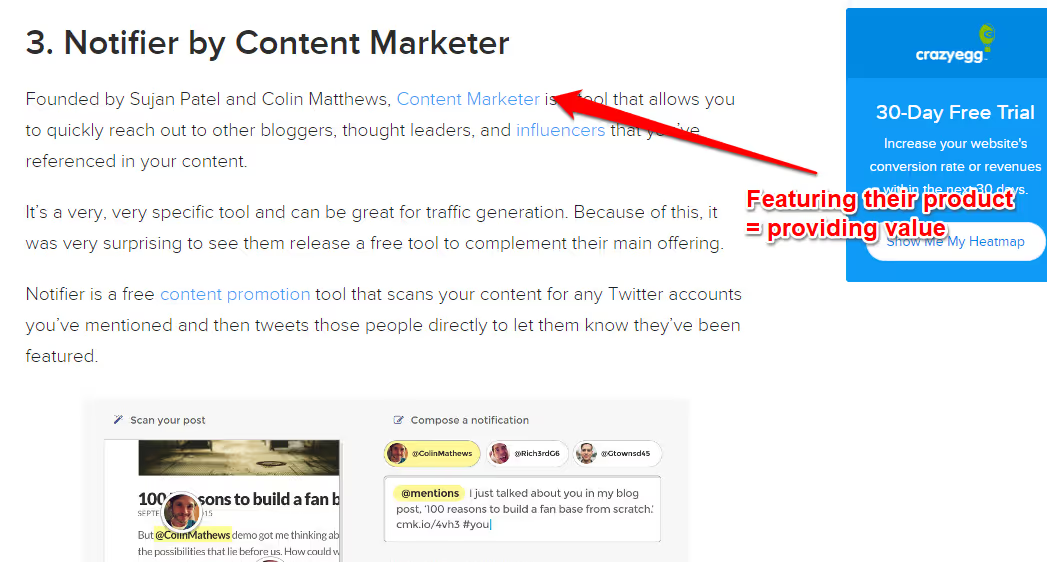
The second approach is to find a common theme that links your content to your target influencers.
Let’s say you’re writing a piece on content distribution, and you want to connect with CMOs at technology companies. The approach would look like this:
- Position your article as a content distribution guide for SaaS companies
- Identify 10 to 20 CMOs with access to your audience/work at target accounts
- Interview them about their distribution strategy, predictions, and results from their efforts
Finally, you can dedicate an entire piece of content about a single target influencer. This approach is especially effective if the influencer conquered a challenge that your offer solves.
Here’s an example of this in action on the Fieldbloom blog:

As you can see, the article positions Sarah Jones front-and-center. The result is a thorough and actionable case study that exposes Sarah to a wider audience.
Here’s a simple formula you can use to come up with story-driven articles:
“How [INFLUENCER/BRAND] Grew/Generated/Reduced [PROBLEM] [QUANT] in [TIMEFRAME] by [ACTION]”
Let’s break each element down:
- Influencer/Brand: The individual or organization you’re featuring
- Problem: The challenge they solved or the results they generated
- Quant: Provide specific numbers on the results
- Timeframe: How long did it take them to achieve this?
- Action: How they got those results. This is the topic of the article
From here, you need to create a killer piece of content. Whichever format you choose, it must be actionable and practical.
Take the insights generated from your conversations and provide actionable takeaways for the reader. You’ll learn how to do this in step 4.
Step 3: Influencer Engagement They Can’t Ignore
The most difficult step to influencer engagement is “getting past the noise.”
Here’s the good news:
The methodology outlined in this guide is designed to cut right through it.
Getting an influencer featured in industry and business publications is a sure-fire way to grab their attention.
The best method to reach out will depend on each target influencer. And to make matters worse, once GDPR ruins everything in May this year, you may want to diversify away from email.
Regardless, here’s how to reach out to B2B influencers and begin the relationship.
Pre-Engagement for Familiarity
While not always necessary, you can get on an influencers’ radar before reaching out.
Let’s look at some common methods of building familiarity.
Yes, I’m aware a “poo-pooed” these at the beginning of this guide. But these techniques are designed to nurture, not as a way of pretending to give superficial “value.”
- Comment: If they’re publishing content, add meaningful comments. By meaningful, I mean useful. Don’t just say “Nice post!” Ask questions, add your “two cents” and inspire debate.
- Social Engagement: Respond to their posts on Twitter, Facebook, and LinkedIn. Go beyond “likes” and get involved in the discussion. Tweet at them, comment on their posts and mention their name when sharing their content.
- Communities: Find the forums and groups they’re active in and get involved. You can do this directly or indirectly. Indirectly means contributing to the entire community.
These are just a few easy methods of getting on an influencer’s radar. The underlying principle is a simple one:
Go where your influencers are and start a conversation with them.
Influencer Email Outreach
If you can find the right email address, this form of outreach is often the most effective.
I’m not going to share any templates. They can quickly saturate and ruin an approach. Instead, here’s a framework you can follow to write your own:
- Personalized Opener: The expectations on personalization moved on long ago. “First name” variables no longer count as “personalization.” Instead, reference conversations and content where your paths have crossed.
- Get to the point: State why you’re reaching out, and why it’s relevant to them.
- Take the lead: The responsibility must be on you. Whether you’re guest blogging or creating co-branded content, you should be the one taking care of the heavy lifting. Make this clear to them and working with you will be a no-brainer.
- Soft CTA: Your call-to-action shouldn’t be assumptive or pushy. Simply ask them if they’re interested in collaborating.
[[component]]
If you’re reaching out to executives within an organization, Elucify is a great lookup tool for professional details and email addresses.
Social Engagement
Use the following approaches if you’re unsure of the legal aspects of cold outreach. This is a hurdle will affect many of us thanks to GDPR in 2018 and beyond.
Start with Twitter. Send a DM if your target influencer follows you. Use the same principles laid out for email outreach above.
If they don’t follow you, then you’ll have to tweet @ them. You have less room to make a case here, but 240 characters should be enough.
Get to the point quickly. “Hey @username, I’m writing a piece on TOPIC for PUBLICATION and wanted to get your thoughts on CHALLENGE THEY OVERCAME. Can I DM or email you?”
Alternatively, there’s LinkedIn. When connecting with your target influencer, add a personal note to state the intention. A note will increase the accept rate on your connection requests.
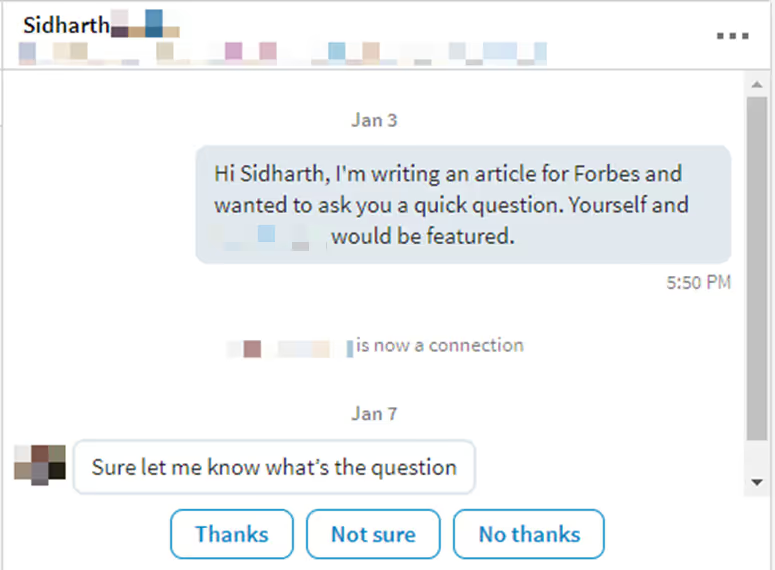
(Details blurred out for privacy)
What if influencers don’t respond? Try again on another channel, and keep following up until you get a “yes” or a “no.” Persistence is key, especially if you believe you’re adding real value.
Step 4: Influencer Interviews For Awesome Insights
So, you’ve established a relationship, and you’re ready to create content or establish a partnership.
Influencer interviews are the final step. Here, you’ll learn how to set up these discussions, the right questions to ask and how to turn their insight into content.
1. Digital Interviews
Some influencers just don’t have the time to chat with you on the phone. Deal with it and interview via digital channels.
I took this approach when creating the CrazyEgg post mentioned earlier. In fact, I conducted an entire interview with Sujan Patel on Twitter:
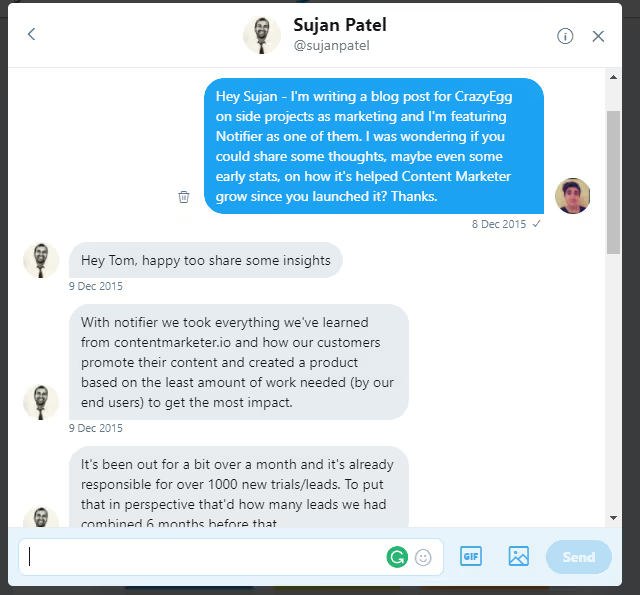
Just like any other interview, you can then dig deeper into their responses to understand the larger impact and thought processes behind these strategies.
Don’t let them drag on too long. Try and limit to three to five exchanges. Otherwise, you’ll see response rates drop.
2. Phone Interviews
Interviewing over the phone is the preferred approach for two reasons:
- You can dig deeper into responses while getting honest, raw insights on their motivations, needs, and experiences.
- It’s much easier to build rapport and lay the foundations for strong, long-term relationships.
When asking influencers for the interview, give them the option to talk on the phone or via email, Twitter, or LinkedIn.
What should you ask them when you have them on the phone? Here’s a framework I’ve borrowed from customer development frameworks.
- Really, really listen: Don’t wait your turn to respond. Instead, soak up everything influencers have to say. Learning to listen will help you use the next principle.
- Be open: Avoid scripts at all costs. Instead, ask questions that probe and dig deep into their answers. Allow yourself to be flexible depending on their response.
- Don’t lead: Avoid questions that imply an answer. E.g. “What impact did your side project have on lead generation?” vs. “How did this side project impact your business?” You’ll get more insights this way.
- Make friends: People do business with people they like. Spend one or two minutes at the beginning of the call to learn more about what they’re up to, but get to the point quickly.
Go in with three or four open-ended questions. Let their responses drive the rest of your questions. Get an understanding of the true impact their experiences and results had in their business or career.
Turning Influencer Insight into Content
You’ve conducted the interviews, and you have pages of notes. It’s time to turn that insight into content.
Your content must be actionable and practical. Whether it’s a guest post, webinar or podcast interview. The reader/listener should be able to execute on what you teach.
A good litmus test is to ask yourself “does this thoroughly guide me through the solution?” If the answer is no, add more detail to your content.
The introduction should outline the challenge, pain or complication in the market. What’s the problem that your content is about to solve?
One way to boost credibility here is to include third party data and statistics. Cite them when backing up your points throughout the entire piece of content.
Influencer insight will allow you to tell a story. What was the challenge, and why was this such a pressing problem for them and their business? How did they overcome these challenges?
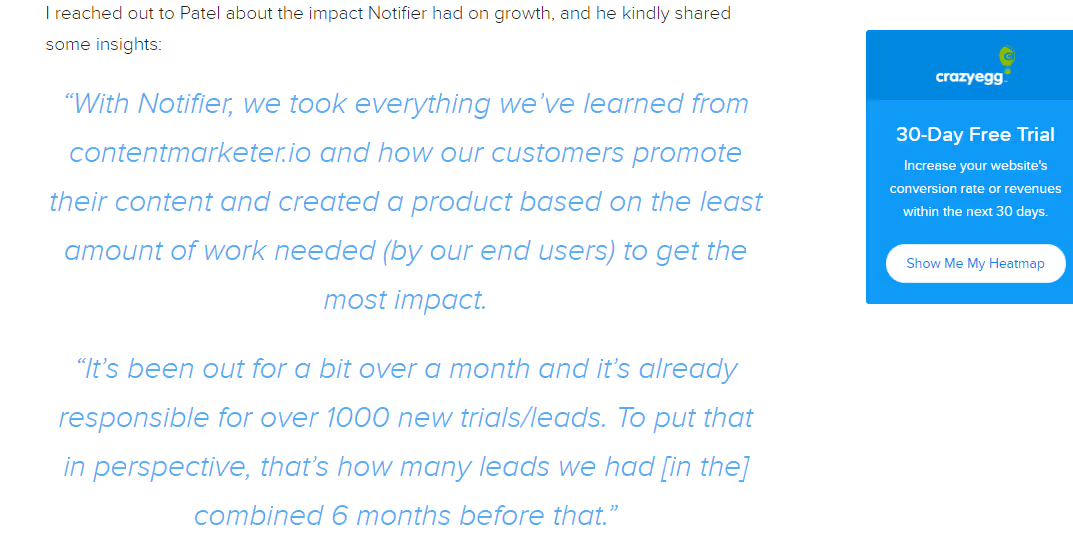
Then, it’s time to drive practical value. Extract takeaway lessons from your influencer’s story. Provide actionable steps with examples, screenshots, and instructions on how your audience can do the same.
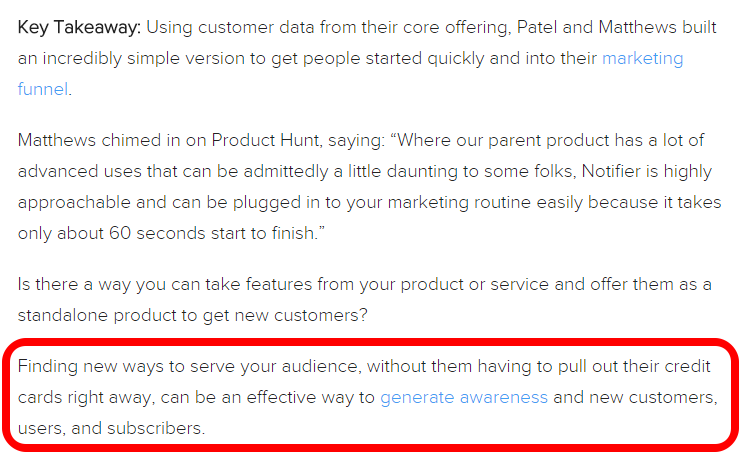
Include as many quotes, statistics, examples, and images as possible. These ramp up the perceived value of your content, leading to more shares, traffic and, most importantly, leads.
Conclusion
This methodology is designed to work across all platforms and content formats.
Looking for interview opportunities on podcasts? Need examples for an upcoming webinar? Influencer interviews will help with that.
The importance is that you’re adding value to all three parties:
- The creators or editors for the platform/publication your content will feature in
- The influencer you’re engaging with
- You and your business
Drive as much value to all three, and you’ll see your audience expand rapidly.


In this article, we’ll show you an agile video production process to help you build and scale your media marketing efforts.
Aligning video content with marketing objectives
The purpose of video marketing is to support demand generation and user acquisition. Done right, video content inspires action while contributing to a delightful user journey.
For example, here’s how video might contribute to different stages of a product-led user journey for digital PR software:
- Awareness: An agency founder (a segment of the digital PR brand’s ICP) watches a social media video created by an employee that talks about the importance of building journalist relationships. They then watch a long-form YouTube video on setting up outreach systems for clients.
- Acquisition: The agency founder visits the brand’s website and navigates to the agency use case page. They watch a video that dives into how specific features apply to their needs and sign up for a free trial.
- Activation: Thanks to proper segmentation, the agency founder—now on a free plan—receives a tailored onboarding experience and product video. It shows them how to get started using features that will help them kick off outreach for a single client.
- Retention: The user receives an invite to a webinar that dives deeper into how to use the product across their entire client base, including managing multiple inboxes and personalizing outreach for several audiences. The agency founder requests their team to attend and come up with action points.
- Revenue: Thanks to segmented email workflows and an increased number of users across the account, the agency founder enters their credit card details after they hit usage limits.
Here, video allows the digital PR brand to make a bigger impact by hooking their audience and nurturing segments to conversion as they proceed through the user journey. The formats vary, but each video has a specific purpose.
Drift uses similar tactics to attract and funnel potential users into its pipeline. They use simple animation and motion graphics to produce product marketing videos that educate users on their products:
Drift’s marketing team has also built a library of webinars that dive into new trends and marketing approaches:

This, on top of their library of blog articles, ebooks, and reports, helps position Drift as an educational media brand. The library of content they’ve built attracts an audience looking for solutions to relevant challenges.
Drift has a blog full of high-value content, and it utilizes strong copywriting across landing pages and product experience. Investing in video provides new methods to deliver value and cater to their users’ consumption habits.
Later follows a similar blueprint, going all-in on video with its Instagram training videos. Video is used as a platform for:
- Collaboration: Later partners with social media experts to present and share their experiences. This gives Later’s audience more value while tapping into a wider audience.
- Positioning: Later doesn’t offer “just another webinar.” You’re enrolling in an in-depth course that will help you achieve a specific result for your business.
- Design: Landing pages communicate huge amounts of value and look visually stunning:
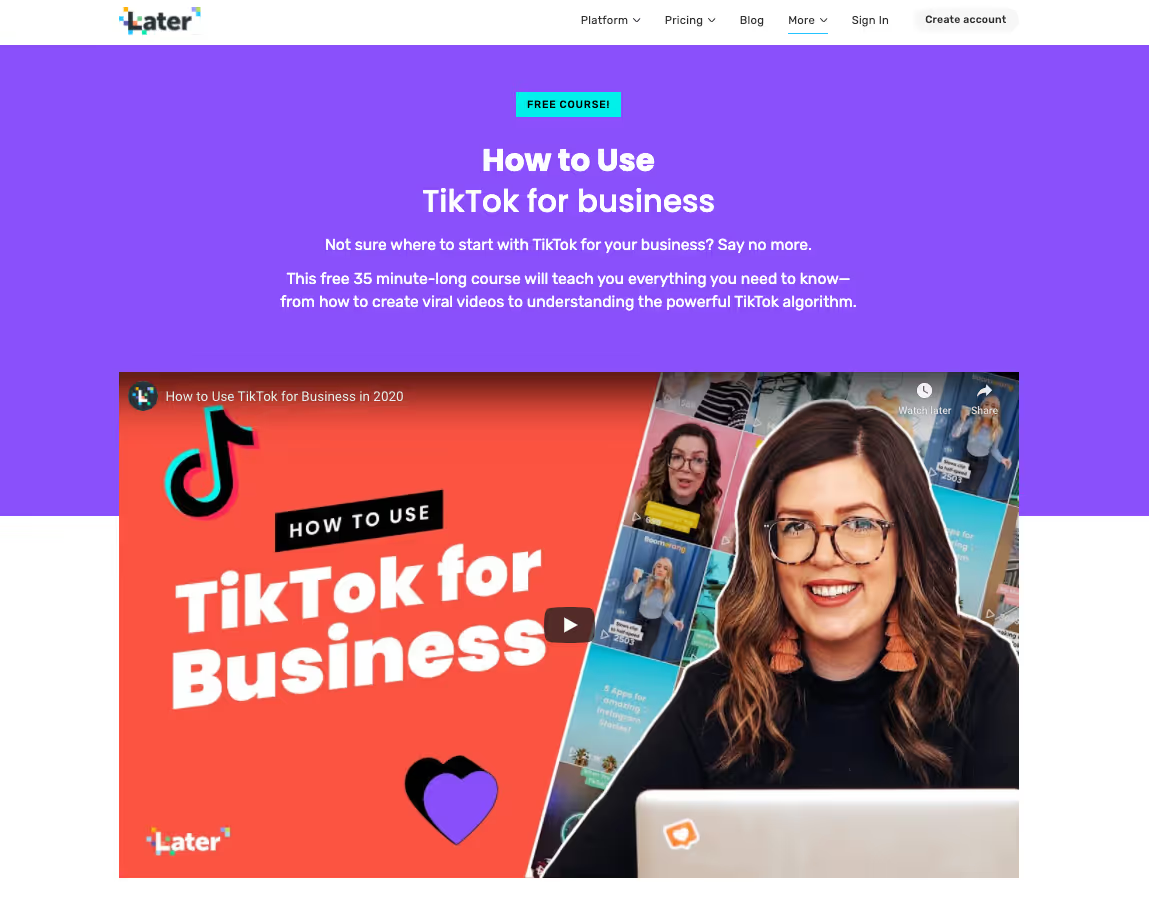
Video content and employee advocacy help position Later as a trusted authority. Empowering Later’s roster of experts helps them build a personal connection with users at scale.
Take stock of the channels and marketing strategies you’re already investing in. Find ways to deliver more delightful experiences by adding video into the mix.
A video production workflow that scales with ease
Many marketers assume video marketing involves lengthy lead times and large production teams.
This is mainly due to how many traditional production agencies still use old school playbooks. Dozens of middle-men have a stake in the creative process. Not only does this bloat production timelines, but it’s also incredibly expensive.
By the time a creative brief has reached the talent needed to produce that content (such as videographers and animators), most of the budget has already been used up.
For us marketers, this amount of bloat is unacceptable. Simplifying the process is critical in order to scale efficiently and get it all done within budget.
Once we boil the video production process down to its core 11 components, it starts to look far more manageable. These components are:
- Pre-visualization: Marrying content strategy and visual research, this stage involves gathering reference materials from sources like YouTube, Pinterest, and Instagram—as well as other films, animations, and aspirational video content.
- Script: An important step to streamline the rest of the process, your script communicates the content, flow of information, tone of voice, and supporting visual cues (motion design, visual motifs, etc.). Good scripts define the narrative and how you’ll communicate your message while keeping viewers hooked.
- Storyboarding: Each “panel” of your storyboard communicates visual elements, content, imagery, and the layout for your video content. Most importantly, it allows all stakeholders to agree on the video’s direction to reduce expensive and time-consuming revisions later on in the process.
- Music production and voiceover: Sourcing background tracks (known as the “music bed”) and voiceover talent early on will aid editors, animators, and motion designers throughout the process. It informs the flow, pacing, and overall “vibe” of your video.
- Animatics and skeleton edits: This is where imagery, audio, and stock footage are used as placeholders for the final edit. This allows editors to build pieces of the final product as new videography and animation assets are delivered.
- Shoot day: Coordinate videographers, locations, and any direct-to-camera talent (unless someone from your team will step in front of the lens). Batching shoots for several videos at once helps to accelerate the production process.
- Editing: Footage, motion graphics, and animation is gathered and crafted into a finished narrative. For some projects, this process will be ongoing from stage three onwards.
- Colour Grading: The process of balancing and altering colors to capture a specific look and feel. This includes raising lighting levels in darker scenes.
- Visual effects (VFX): Can include simple environment alterations (replacing clouds shot on set with a bright, sunny sky), stylized sparkles from a magic wand, or complex set replacements (actors shot on green and blue screens).
- Animation & motion graphics: These two are used interchangeably and can be added to live video or used as a storytelling vehicle for the entire video.
- Rendering: The final product is signed off, rendered, and exported. Your video must be rendered in the right format for the purpose and platform you intend to use it on.
Great video content used to require dozens of directors, producers, and creatives. But the workflow outlined above is lean and simplified, speeding up the production process end-to-end. It removes unnecessary expenses, all while ensuring the final product is perfect.
Much of this process can be done once and replicated with templates. For example, coming up with motion graphic elements that can be reused in the same way across dozens of social media videos.
Another point of friction when producing video content is the fear of stepping in front of the camera. As Vidyard says, it’s a lot less scary when you’re not making it up as you go along:
“If you’re planning to record yourself, set aside a little time to determine what your message is. Plan out your main talking points. Make some notes.
“If you’re going to be in a scripted video production, ask to see the script in advance to review and get to know your lines
“Regardless of the situation, it’s always going to be easier when you know what you want to say.”
Preparing a script will help you feel more confident when standing in front of the camera. It also allows you to produce a tighter and more compelling message.
Detailed brand guidelines make this process even smoother. For example, Shopify’s brand style guide includes several detailed breakdowns of visual elements:
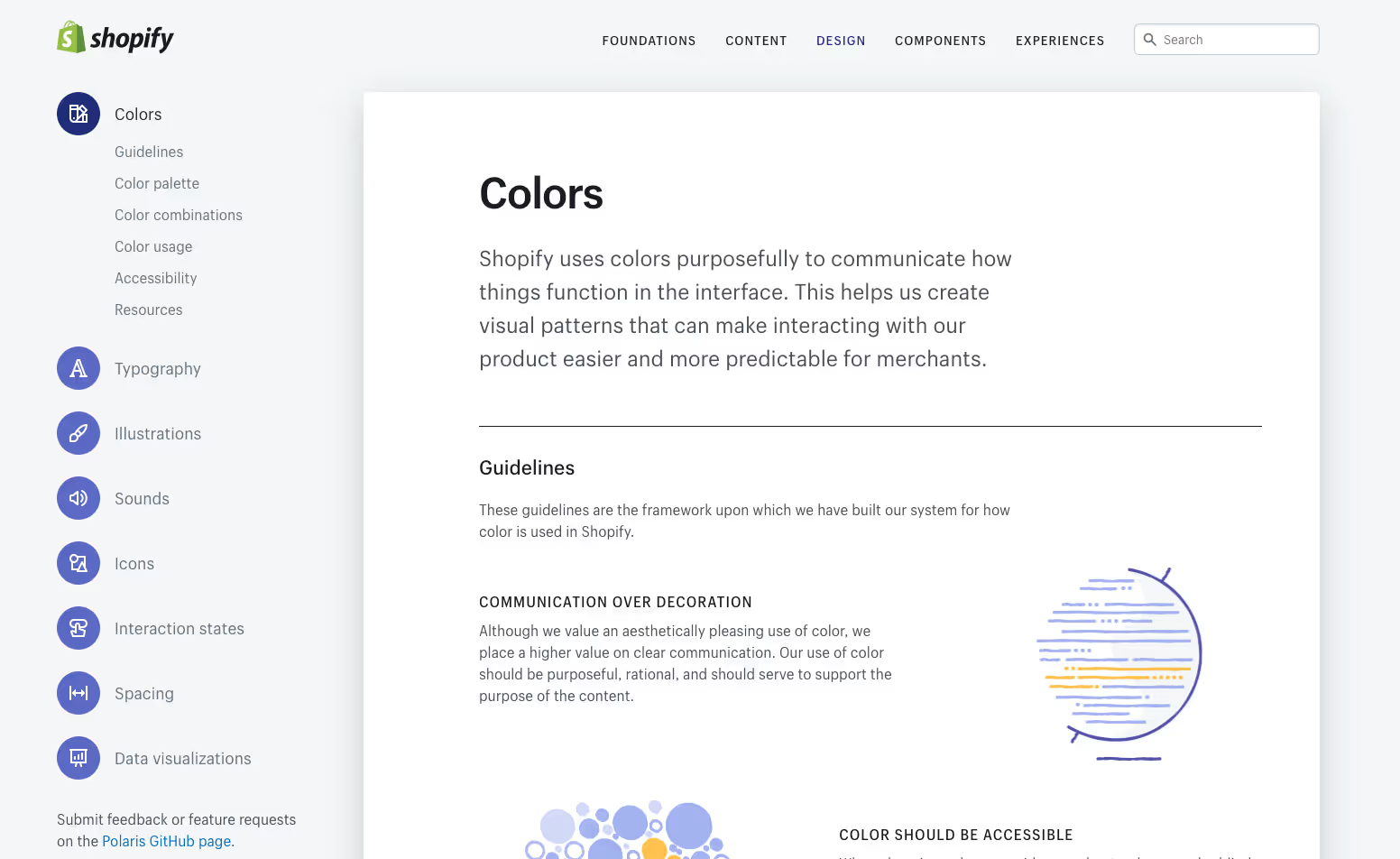
Typography, color, iconography, and even interaction states (e.g. how button colors change between clicks) have been given careful consideration.
Brand guidelines allow Shopify’s team of creators to produce beautiful experiences without dozens of unnecessary and frustrating revisions.
While creating video content may seem like a daunting process, it becomes far easier after the first project. Start with a pilot to get your production house in order. Document the process and standardize elements into a visual style for your brand guidelines.
For example, when we begin working with new video marketing clients at Grizzle, we only commit to a single project in the first month. Once completed, assets are standardized and templated. This allows us to scale to eight video projects a month (and many more when repurposing for short-form video).
Imagine having a single video operation that serves all divisions of marketing and sales from one place. Over time, it becomes easier to test new ideas—without needing a six-figure budget for a single campaign.
Sourcing video talent
The workflow above exists to make life as easy as possible for all parties. But you still need the right people with the right skills to bring your projects to life.
If you’ve collected plenty of reference material, then a good videographer, motion designer, or animator can remove the need for a creative director.
The same goes for production crews. By boiling the process down to critical stages, you only need a single project manager or producer.
At a minimum, these are the people you need to take a video from idea to output:
- Videographer: Takes care of preparing the location, prepping your team or on-screen talent, and supplying filming and lighting equipment on site.
- Motion designer: Adds visual elements to your video content.
- Animator: Produces animated video from start to finish (or animated elements for live action).
- Editor: Takes the raw materials of your video and organizes it into a narrative based on your script. Good editors will obsess over timing to make sure your content is engaging.
- Producer or project manager: Sources and coordinates the right talent, locations, and assets. Ensures projects are kept on track and in scope.
- Content strategist: An in-house marketer or agency to take ownership of video ideation, premise, and promotion activity.
Batch stages of the process together. If you commit to a particular format or framework (and use a script and set processes), you can produce several video assets at once. This will reduce costs while allowing you to scale for a faster turnaround.
For example, if you’re aiming to create four long-form YouTube videos a month, shoot the live-action portion in one day.
When looking for talent, use job boards like Upwork, LinkedIn, and YunoJuno. You can also find specialists on websites like Soho Editors and The Voice Over Network.
Finally, take a leaf out of Wistia’s book and attract a crew that believes in your vision:
“Ideally, you should aim to hire a director, director of photography, sound producer, and gaffer (i.e., lighting technician and head electrician) who are all aligned with your creative vision and direction; any arguing or push-back will be a big time-suck once you’re on set.”
Streamline processes with video frameworks
Like any marketing activity, a proven framework helps you get started with less friction. You can then “break the mold” and test new and creative formats as you grow.
These frameworks provide you with the building blocks needed to share a narrative that keeps viewers engaged.
It’s easy for your audience to click away on the next shiny thumbnail they see. Your job is to keep their attention while adding as much value as possible.
Luckily, there are frameworks that work for every objective and video format. Here are four frameworks used among product-led brands:
1. Explainer videos
Explainer videos are typically used to communicate the benefits, features, and problems your product solves.
High-quality animation and motion graphics are key, as they allow for engaging and entertaining storytelling while keeping your customers wanting to learn more about your product.
But there’s a trap many fall into when writing explainer video scripts: focusing too much on outlining well-known problems.
Users are smart. They can fill the gaps on how a tool applies to their specific use case. The first 10 seconds should “call out” your audience by their challenges before moving on to specific, relevant problems and the features that solve them.
For example, many SaaS explainer videos spend 30 seconds outlining pain points that the viewer is already fully aware of:
With some careful scripting, these surface-level pain-points can be simplified into two sentences. This demonstrates you “get” your audience while quickly cutting to the chase.
Specific pain points can be tied to features and JTBD. For example, this line:
“Stand out from the crowd with stunning templates that go way beyond the standard PDF.”
Can be repositioned to:
“Make a great first impression with prospects and decision makers with stunning proposal templates.”
Not only does this framework get to the good stuff quickly, but specific solutions and outcomes are also associated with each feature set.
Companies are flogging a dead horse by reminding users of their surface-level problems. And we’re bored of it. Get to the point and go deep in order to stand out. Here’s a simple structure you can use for your next explainer or product video:
- Introduction: Two or three sentences, no more than 10 to 15 seconds. Be succinct and get specific with the problems that really inflict pain on your users.
- Core features: Introduce your product and get right into it. Showcase three or four of your core feature sets, including outcomes and what makes them different.
- Social proof: Feature customer reviews, G2 ratings, and testimonials. Show your audience why they should trust you.
- Call-to-action: Ask the viewer to take the next step in the relationship.
2. Webinars
Webinars are a tried-and-tested format for lead generation. But they have a positioning problem.
Take a look at the majority of webinar landing pages, and you’ll notice a lack of compelling copy. Great webinar landing pages make users truly want to turn up and watch them.
Content positioning is a principle we use on all our content at Grizzle. It’s a statement we include in all of our briefs. The sole job is to answer the question: “How will this content be compelling, different, and better?”
When someone sits down to watch a live webinar, you’re in control of their time. If it’s a topic they care about, it’s hard to switch tabs and watch later without completely losing attention.
One of our favorite webinar formats is the case study. As TwentyThree put it, it’s a great way to build trust and move prospects along the sales funnel:
“The format is a great way to bring your case studies to life, either by repurposing your video or written case stories or creating an entirely new one.
“You can either interview the client or let them talk about their experience. However, the best case studies all have one thing in common: great storytelling. You should ensure that your speakers have a proper narrative and storyline, including the problem, the resolution, and the (happy) ending.”
To effectively position your webinars, you must do three things:
- Go deep on a topic
- Overload your content with value
- Communicate every single thing a viewer will learn (and what they can achieve) in your landing page copy
Here’s a webinar framework you can use to structure your training:
- Topic Introduction: Open up with a story that connects with your audience (while remaining relevant to the topic). Avoid talking about your product at this stage.
- Expert Introduction: Once you have their attention, introduce yourself (or any experts you’re collaborating with) to ease skeptical minds. Why are you qualified to be teaching this?
- Introduce what they’ll learn: Briefly provide a high-level overview of what you’ll cover and why each element is important.
- Value, value, value: Treat the rest of your webinar like a how-to blog post. Provide actionable steps, strategic advice, data, and third-party examples to help visualize each principle in action.
- Conclusion: Wrap up overarching themes. Remind them why this topic is important and what they can achieve by taking action.
- Call-to-action: What’s the next step? Craft an offer that guides the user forward in their journey.
Creating beautifully designed slides will differentiate your webinar, keep your audience engaged, and improve the experience. Go all-in with your slide designs to make an impact.
3. Long-form video
YouTube is the second largest search engine in the world. For SaaS and product-led teams, it’s a blue ocean opportunity due to how many marketers are sleeping on it.
For example, Semrush uses its YouTube channel to produce educational and product-led video content:
The video above teaches viewers how to find keyword opportunities with low competition, featuring the Semrush platform as a way to fulfill relevant JTBD.
[[component]]
Plan and batch several projects at once. Spend a couple of weeks producing four scripts. If you’re producing direct-to-camera format, shoot all four of them on the same day. This will accelerate the production process and increase your publication velocity.
Alternatively, you can use a “remote” format by utilizing voiceover talent (in-house or external) overlaid to animation and motion graphics.
4. Social video
Bottom-up SaaS is an increasingly popular go-to-market approach. Targeting your end users and generating freemium users helps you build advocacy across entire organizations large and small.
Because of this, social media is a critical product-led marketing channel. Social video content helps you build thought leadership and connect with your audience at scale.
While the sheer production quantity needed to get traction may seem daunting, there are three methodologies you can use to accelerate the process:
- Employee advocacy: Individual contributors and leaders hold a wealth of knowledge. Create a program that makes it easy to get them in front of the camera and share it.
- Repurposing: Take your long-form videos and podcast episodes and cut them up into shorter snippets.
- Hire creators: Build out a team of video and social talent to build and execute on a multi-channel content strategy.
For example, cold email SaaS brand Lavender blends all three of these methodologies together, making a big impact on social that’s amassed 28,000 followers on their LinkedIn company profile alone:
Here, Lavender’s social marketer, Will Aitken, uses short-form video to outline a cold email framework that their users can test. It just so happens to be even more effective when used with Lavender’s product.
Build processes and systems around internal talent and existing content assets. Find employees who come alive and feel natural in front of the camera. Make life easy for them to share their expertise with your audience.
Video marketing made simple
We created this process to cut the fat and waste from video marketing.
Reducing bottlenecks in the process makes a cinematic level of video quality a realistic goal for any marketing team.
Simplify the process by hiring the right people and putting the necessary processes in place. Try it once and produce templates from your first project. Scale your efforts to increase production velocity and start engaging users on a personal level.


In this article, we’ll share the content optimization methodology we used to help an enterprise software company get the following results by optimizing their existing content:
- 269.98% increase in organic traffic
- 202.41% increase in overall traffic
- 110% increase in user-sign ups
Let’s dive in.
🤫 We’ve included anonymized client data throughout this article. While we love a good breakdown, client confidentiality must come first.
What is content optimization?
Content optimization is the process of auditing and updating your existing library of blog posts, articles and case studies to increase organic traffic, engagement and conversions.
When conducting content optimization for the first time, it’s important to take a site-wide approach. Treat it as a project to maximize and capitalize on your existing content assets over a shorter period of time.
This article will show you the methodology to do this, along with advice on how to build an ongoing process as part of your broader content strategy.
Identifying optimization opportunities
It all starts with a content audit. By taking stock of your existing library of content, you can identify and prioritize the opportunities available to you.
Typically, we look for content optimization opportunities that sit within two lanes:
- Content that can be optimized to increase rankings in Google
- Conversion rate optimization (CRO) opportunities from content that generates sufficient traffic
For the former, the biggest opportunities are those ranking on page two or three for critical keywords. At Grizzle, we use data from Google Search Console, Ahrefs and various other sources to identify these:

Using a scoring system, analyze each opportunity based on volume and keyword difficulty (KD) to evaluate how quickly you can improve results.
Each piece of content then goes through an evaluation process. This starts with the content asset itself, identifying areas that are outdated, gaps that need addressing and ways content can be improved for depth and originality.
Compare each article against your content competitors. Analyze top-performing articles, what they have in common and their weaknesses. We usually score content competitors against three categories:
- Content Competition: How comprehensive is the content? Does it include proprietary assets we don’t have access to? What can we add that they can’t?
- Backlink Competition: How many domains are linking to them? How fierce is the competition?
- Content Opportunities: What do we need in order to create the best piece of content on this topic and overcome the competition?
Clearscope is another tool we use at this stage, which provides data that drives what information to include in our updated content.
Re-distributing content is a critical part of the optimization process. However, backlink acquisition is not always necessary. If our content provides a better experience (and is more comprehensive in nature), then it’s possible to beat the competition simply by making our content stronger.
In fact, this is exactly what we did for another client that was stuck at the bottom of page 1 for a competitive broad term in the marketing space. After updating the content and optimizing it for this specific keyword, we ended up increasing organic traffic by 287%:
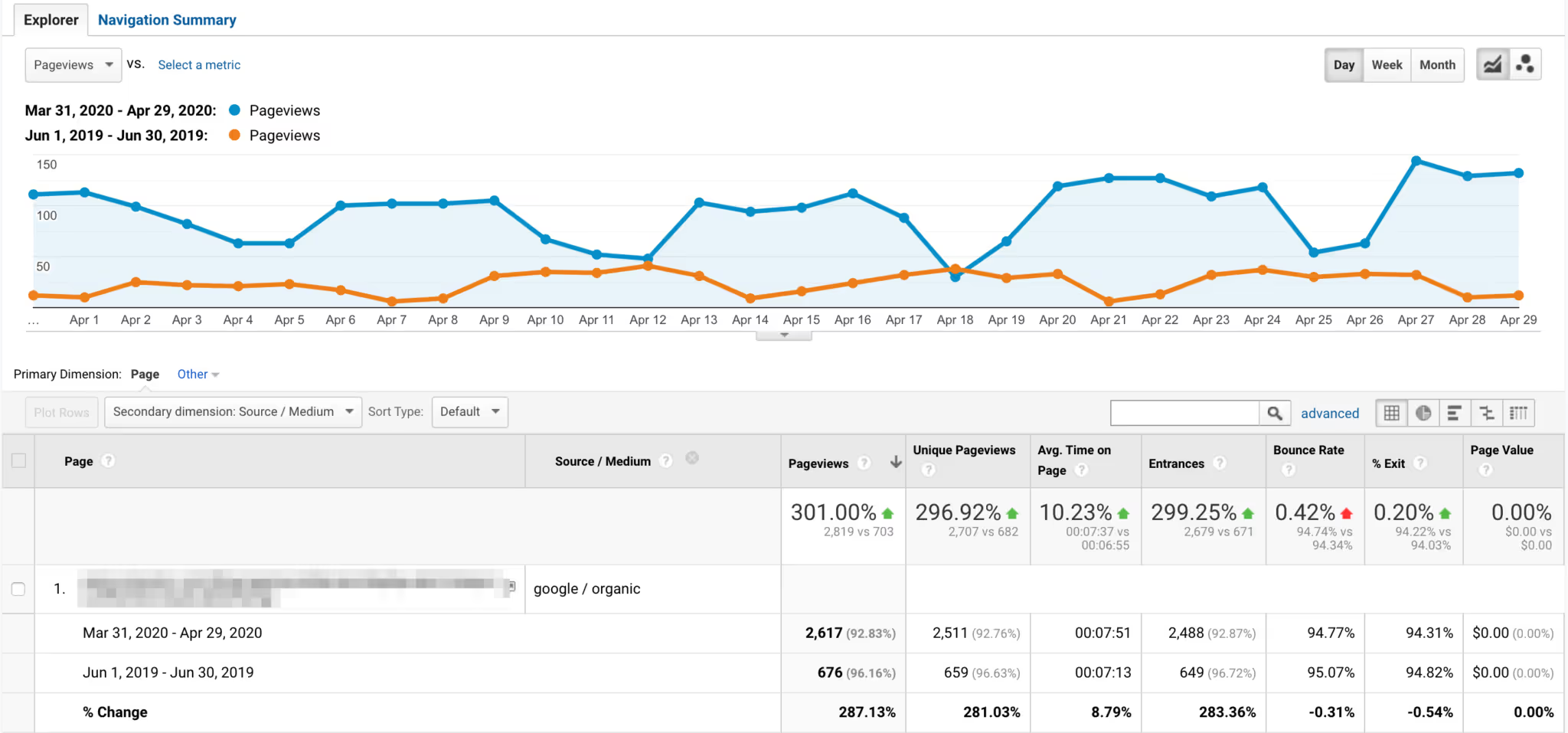
In another example, this article we created for Sales Hacker outranks the likes of HubSpot for a keyword that’s hard to rank for. Even though it has far fewer backlinks than other results, we still outrank them:
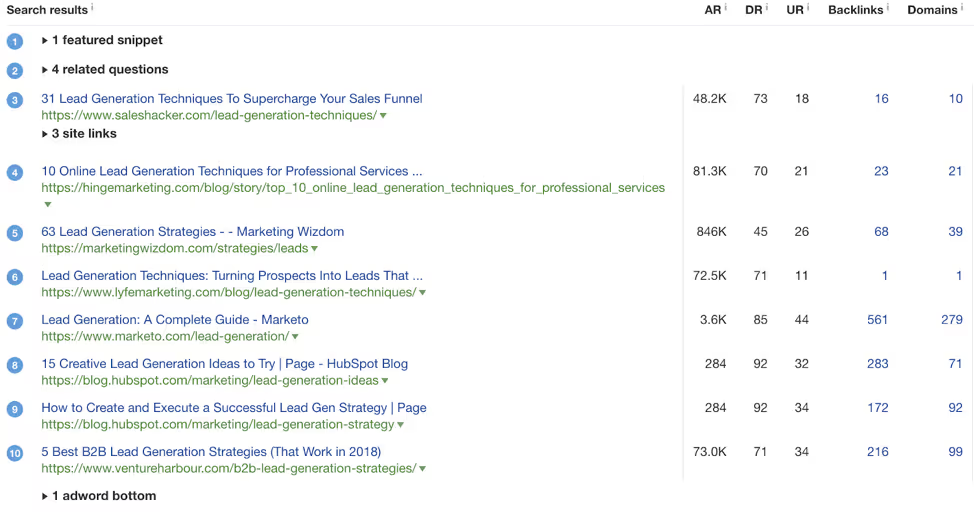
Finally, decide whether your content simply needs something extra (two or three paragraphs here and there) or a complete overhaul. If all it needs is some additional value, we’ll usually edit the content and fill any necessary gaps. However, outdated or shallow content often needs producing from scratch.
Planning and producing optimized content
With your optimization opportunities revealed, create a content brief to define your goals and create a detailed outline.
This brief should include competitor information (detailed above), SEO data and influencer marketing requirements. Thorough planning will improve the likelihood of success. To do this, you must aim for a delicate balance between giving Google what it wants, writing for people and making the content as original as possible. Luckily, you can have your cake and eat it too.
Use the data uncovered in the previous step to direct your content outline, ensuring it covers all bases while providing an original and value-driven narrative.
At Grizzle, we do this by collaborating with subject matter experts and content creators. They lend their insights, expertise and stories to provide a fresh perspective. This journalistic approach to content creation builds credibility, and helps distribute content through existing audiences.
While there are dozens of ways you can make your content original and valuable, some of our favourites include:
- Taking a fresh approach: Don’t follow the SERPs. Instead, look at what people care about right now, and tailor your content to those immediate needs.
- Adding depth: Provide additional advice and takeaways on granular ideas. Expand upon threads wherever possible.
- Collect proprietary data: Tap into your audience and use owned data to conduct research or uncover trends.
- Experience & design: One thing I still love about Brian Dean’s content is his use of design (like in this example). Can you create a bespoke experience for critical and strategic content pieces?
- Contributions & citations: Involve other thought leaders and experts in the content creation process. Not only does this enhance your content, but it provides access to a new audience.
You can also tap into visual content and video to enhance your content experience. For example, in the first section of this article, you saw an animation we created describing the optimization process. You can also create something as simple as an animated gif, like we’ve done for this article on bottom of funnel content:
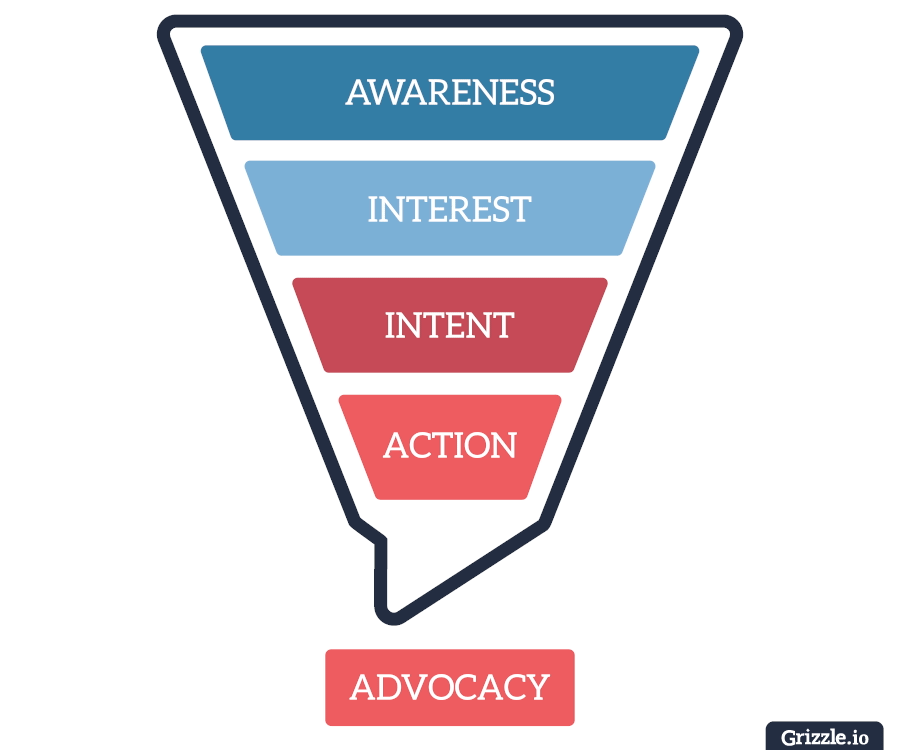
Most importantly, ensure that your existing content aligns with your current content strategy. For example, if you’re currently attracting new audience segments, moving upmarket or pivoting your distribution strategy, some articles and blog posts may no longer be relevant.
During the auditing process, focus on and prioritize the content that aligns with your current priorities.
Grouping together and merging similar themes
On top of optimizing individual blog posts, keep an eye out for content with overlapping topics. As part of the auditing process, group together content that covers similar themes.
For example, you may have recently created an article that provides in-depth and up-to-date advice on writing great ad copy. During your audit, you find the following complimentary articles:
- “How to Write Ad Headlines”: The term “ad headlines” generates 250 searches a month, and warrants its own article. Instead of merging this with your latest piece, update it and include an internal link.
- “X Principles of Great Ad Copy”: Upon inspection, this article might be several years old and extremely thin. Therefore, take relevant elements for your updated content and create a 301 redirect.
- “How to Write Ad Copy To Generate Leads”: While this may first seem like an overlapping topic, you may find it’s a common customer challenge. Make sure you exclude content that serves a specific purpose (conversions, sales enablement etc.) from the merging process.
Look at each blog post through a discerning lens. Check your analytics data to see how it’s performing across the entire funnel. Check-in with other teams to uncover the content that makes up their own toolkit.
This will help you increase your traffic, demand and acquisition efforts while maintaining the integrity of your growth engine.
Optimizing content for conversions
The second optimization lane involves taking a conversion rate optimization (CRO) approach. These are identified by identifying content assets that are generating a high amount of traffic, but can be improved for conversions.
To find these right experiments to run, ask yourself the following questions:
- Does the offer match the information the audience is looking for?
- Are we offering something of true value?
- What calls-to-action (CTAs) are being used?
- What CTAs is most appropriate for this audience?
For example, most senior decision-makers are looking for strategic advice. Therefore, it’s unlikely they’ll be interested in downloading an eBook that offers advice on a tactical level.
Furthermore, different audiences are sensitive to certain CTAs. Exit-intent pop-ups may work, but some audiences have been conditioned to ignore them. Sometimes it creates enough friction for them to abandon content altogether.
In-line CTAs are an effective and non-intrusive way to drive action. In the example below, Pipedrive has a simple in-line CTA that offers additional content around the topic the reader is currently engaged with:

The offer itself is as important as the CTA. How does your lead magnet add additional value beyond the content users are actively engaged with?
The answer: craft lead magnets and offers that serve overarching themes.
For example, an ebook or training video about ad copy could be used on articles that talk about headlines, landing pages and Facebook ads.
Find the perfect balance between your offer, CTA and the placement. Take your audience into account, and consider crafting tailored offers or lead magnets for individual articles.
Re-distributing updated content for fresh eyes
With our content polished up and updated, it’s time to promote. Content distribution is key, but there’s no point in wasting time on ineffective channels just because they exist.
Start with people who shared and engaged with the original piece of content. BuzzSumo is useful for uncovering these individuals:
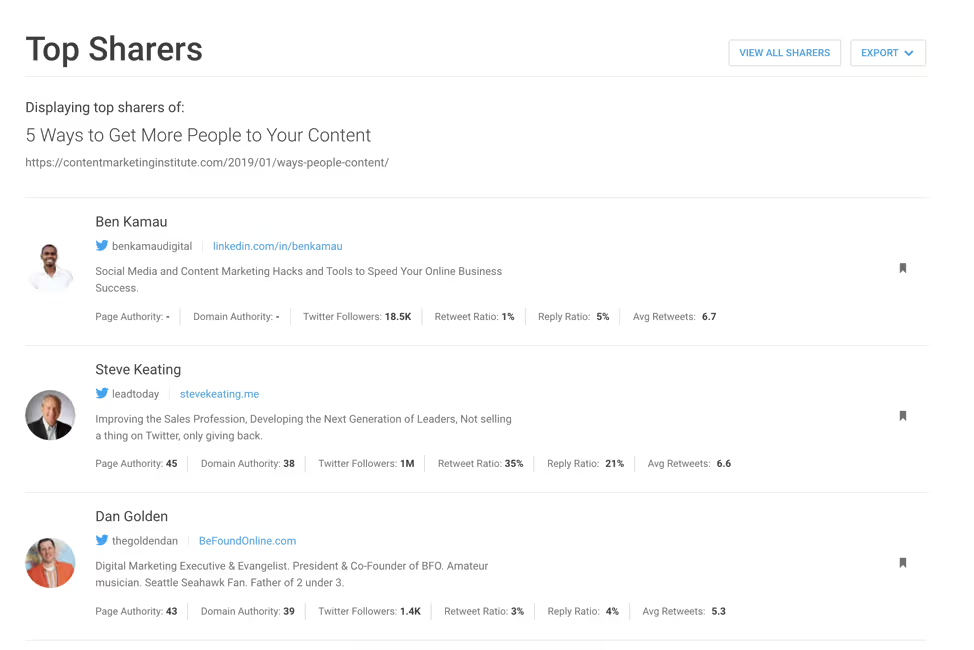
Strong relationships are foundational to content promotion. Being a trusted face on your primary channels will help your content be welcomed with open arms. This goes for all distribution approaches:
- Community engagement: Become a welcome face. Contribute to the conversation and become a trusted source of advice.
- Influencers: Get them involved with your content production. This not only provides you with a new audience to reach, but also makes your content more original.
- Link building: Build relationships with publications and creators. Find ways to add value, collaborate and build relationships. Avoid cold email at all costs.
Don’t forget about your owned assets. If your content has been given a new lease of life, relaunch it to your email subscribers and social media followers. Summarize new elements, and tell them what they’ll learn in this improved version.
An ongoing optimization process
The steps outlined so far will help with one-off auditing and optimization projects. However, it’s well worth building an ongoing content optimization process.
Why? Because it can future-proof your rankings and organic traffic. During Google’s May 2020 core update, Neil Patel (love him or hate him) analyzed 641 websites that updated content on a daily basis:
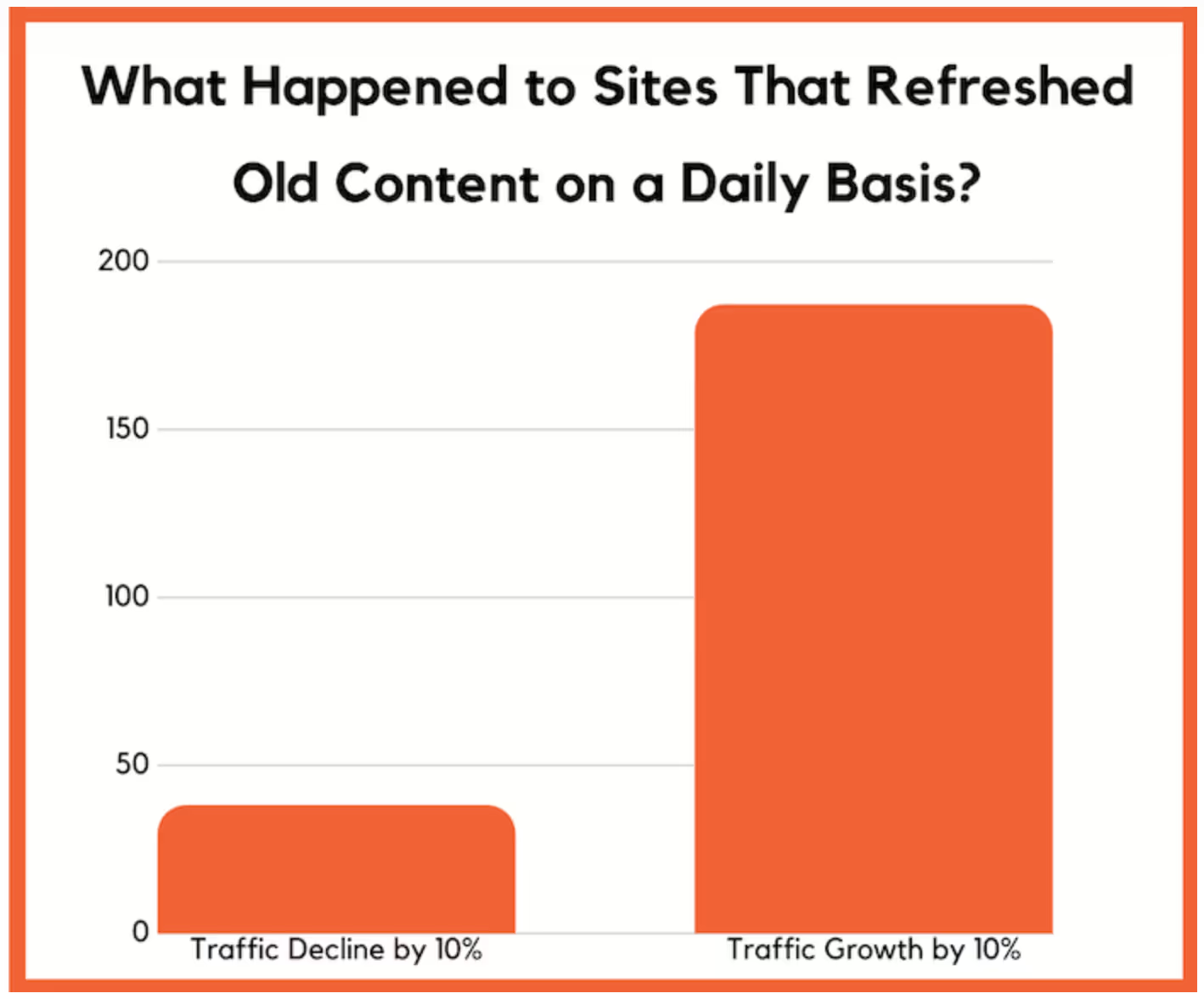
He found that only 38 of these sites (5.92%) saw traffic decline by 10%, which is extremely low for the volatility seen during the update.
However, 187 of those sites saw traffic increase by 10%.
Keeping content fresh and updated on a regular basis will not only increase your organic traffic and conversions, but can protect you against future algorithm updates.
Building an ongoing optimization process requires the following elements:
- Monitor market trends: What changes are happening in your industry that may affect the accuracy of your content? Social media marketing solutions, for example, will need to audit their content whenever a platform updates existing features or launches new ones.
- Monitor your rankings: When you start to see traffic dip, it’s time to act. Keeping your content updated (especially when targeting competitive terms) will help you increase and defend your position on the SERPs.
- Monitor conversions: CRO is a complex battle, so you’ve got to pick your battles wisely. Consider monitoring content against benchmarks and use fluctuations to inform your priorities. Alternatively, identify the 10% that contribute to strategic goals, and go all-in on those.
Building a reactive and pro-active process will help you improve results over time. Even a small 1% increase will compound over time. Start with the metrics that matter most, then build processes to act on them using technology and talent.
Conclusion
Your content optimization efforts must align with your existing strategy. It’s only worth optimizing content if it still has a place in your customer journey.
The philosophy behind content optimization is simple: Treat every piece of content like an asset. Re-invest in relevant content that will help you get better results.
A thorough content audit will show you what to keep, optimize and merge. Prioritize content that will make the biggest impact first, and you’ll quickly make a case for ongoing optimization with the boardroom.


In this article, we’ll outline the content-driven acquisition methodology we use to help companies get results like this:
- Fintech company: Avg. ~5,000 leads generated each month using a content-driven paid media strategy (over a 6-month period)
- MarTech company: Avg. 47% conversion rate from content
- Consulting company: Avg. 42 marketing qualified leads (MQLs) a month
🤫 We’ve included anonymized data throughout this article. Want to learn more about what goes on behind the scenes? Get in touch.
What is Content-Driven Acquisition
Content-driven acquisition is the process of taking marketing channels like Facebook Ads and using value-driven content as the centerpiece of those campaigns.
It’s an approach that utilizes blog posts, lead magnets and other content assets to attract new users and expand your audience. While some may not be ready to buy from you now, you can educate and nurture them into customers over the long term.
It’s great for ecommerce, DTC and consumer tech brands looking to build an audience, as well as B2B and SaaS organisations with lengthy sales cycles that rely on lead generation.
Blending paid & organic acquisition channels
Using content to fuel your paid media efforts can help you:
- Diversify and expand your target audience/visibility
- Generate better long-term results (traffic, conversions and brand building)
If you’re looking to raise funding, it can also help you control your growth narrative. Do this by showing investors you’ve built an active and engaged community.
We’ve seen our partners use content to generate traffic at a lower CPC (and CPA). It also helps us to generate a burst of short-term traffic while invigorating long-term growth.
In other words, you can play the short- and long-term game with every content asset you produce.
Test on a small scale with a portion of your ad budget. Measure the results at all stages of the funnel (subscribers, leads, sign-ups and purchases). If the results are favorable, allocate a higher budget to scale.
This requires you to have a full understanding of your audience and customer journey:
- Without proper targeting, you’ll end up wasting money on unqualified traffic
- Without an understanding of the customer journey, you risk losing sight of the true, long-term ROI
For example, if you’re a DTC brand, you may find subscribers don’t necessarily convert immediately. But they may, on average, make their first purchase in 30 days.
Use long-term thinking as a way to accurately calculate and forecast ROI. The way you segment audiences into cohorts is up to you. Make sure your content efforts are getting the attribution they deserve.
Optimizing content for conversions
You may be creating epic content, but what happens during and after engagement? Are you optimizing your offers and calls-to-action to capitalize on this attention?
For example, readers of a how-to guide might simply want more information to help overcome a specific challenge. Therefore, creating a lead magnet that covers the topic in more depth is likely to drive action.
Conversely, you can include more commercially-driven offers if the topic is related to your product. For example, a coffee subscription brand writes a piece on the health benefits of coffee. They could include a call-to-action to sign up for a subscription at the end of the article.
Generating conversions from your content requires an understanding of the following:
- Context: Why are people reading your content? What are they motivated by? Help them take the next step in this journey by offering the right information or products.
- Experience: Don’t include calls-to-action that ruin the experience. For example, pop-ups that interrupt the reading experience can frustrate some readers.
People are more critical of content these days. Information is abundant, and if you get in their way, they’ll happily look elsewhere.
Using email marketing to educate & nurture
As you generate subscribers and leads, you’ll need to nurture them. This can be done through education, additional content and product offerings.
Your email marketing strategy will vary based on the nature and complexity of your product. Two of the most common formats are:
- Email newsletters: Regular digests containing content and product offers
- Nurture sequences: Automated emails sent over time that are designed to educate the audience on your brand and product
Many marketers use a blend of both. For example, SaaS companies often use email sequences for lead nurturing and product onboarding. I’ve also seen DTC brands use automated emails to introduce their brand before sending scheduled monthly newsletters.
Your emails must guide prospects and customers through the customer journey and give them the content they need, when they need it.
Conclusion
Content-driven acquisition caters to all stages of the customer journey. Each touch-point is designed to educate and empower your audience.
Fostering this approach can be as simple as using content to fuel your existing paid media efforts.
You won’t know until you speak to your customers. It’s the insight they give you that should fuel your content efforts. Listen, and then produce the content they need.
Many brands reach a stage where they no longer wish to rely on paid ads and performance marketing alone. Transitioning to organic acquisition is an attractive prospect.

